Text
Want to Write for Nomadic Matt? Here’s How!
Updated: 04/22/19 | April 22, 2019
Earlier this year, I announced I was opening this website up to guest posters. For years, I turned away unsolicited guest posts, but, this year, I decided it was time to change that policy as I want to add more voices, opinions, stories, and tips to this site.
I want to bring in people out there who have helpful information and insight I might not have, especially now that I’m traveling a lot less.
So, if you’d like to write for this site, here are our guidelines for submissions:
What Content Do We Want?
First, what kind of submissions are we looking for? We’re interested in the following (and only the following) areas:
LGBT content: stories by transgender people, queer couples, and solo gay, lesbian, or bi travelers
Africa-related content (bonus points if it’s East or Central Africa and Egypt related)
Middle East–related content
Central Asia–related content
India-related content
China-related content
Technology- or gear-related content
Your pitches should have a focus on budget-related issues: cheap things what to do, budget accommodation, good companies or apps to use, travel hacks, or ways to save money. We want the kind of service article that will help readers travel cheaper, better, and longer.
Of course, travel stories are great too, so long as they contain a lesson or advice that can be used to help people travel.
Typical posts are 1,000-2,000 words, are super detailed, contain lots of useful links, and have tips and tricks not found elsewhere. I love insider knowledge!
How to Submit a Post
Send an email to [email protected] with the exact title “New Guest Writer Article Submission”
Include the following:
Your travel history
Your blog or channel
A link to two other guest posts you’ve done
Your topic idea(s), with suggested title(s) and description(s) of the article(s)
Here’s an example of a good email:
Hi Matt,
My name is John and I’m writing about submitting a guest post on your site. I’ve been traveling the world for ten years, with a focus on Africa. For the last six months, I’ve been traveling around East Africa as a backpacker and have a lot of resources that can help. My blog is johnsworld.com, and I’ve written some posts on the subject that can be found here and here.
My proposed topic is “How to Visit Tanzania on a Budget,” which will focus on how to get around, eat, and safari without spending a lot or money or doing an expensive tour. The idea here is to show people you can travel the country independently.
Here are links to some of my writing so you can see I can put words together.
Looking forward to hearing from you.
Sincerely,
John
Simple and to the point. If I like your pitch, I’ll reply. Please DO NOT follow up. While tenacity can often be appreciated, DO NOT follow up. I get too many emails.
Please follow the rules above too. I like people with an attention to details so if you send an email with the wrong subject line or miss any of the other following rules, we’ll delete your pitch!
Finally, please note that if you send me a draft and I find that it will be too much work to edit, I reserve the right to reject it. Additionally, since I am pretty picky, there’s also 99% chance I’ll ask you to make changes to your draft so please expect notes and rewrites.
Oh, and we pay $250 USD per post.
That’s really it.
If you have any questions, leave them in the comments.
Matt
The post Want to Write for Nomadic Matt? Here’s How! appeared first on Nomadic Matt's Travel Site.
from Traveling News https://www.nomadicmatt.com/travel-blogs/write-for-matt/
0 notes
Text
5 Best Places To Stay In Mumbai (for all budgets)
5 Best Places To Stay In Mumbai (for all budgets) The city of dreams, Mumbai, often still referred to as Bombay, is one of...
The post 5 Best Places To Stay In Mumbai (for all budgets) appeared first on Global Gallivanting Travel Blog.
from Traveling News https://www.global-gallivanting.com/best-places-to-stay-in-mumbai-bombay-budget-hotels-in-mumbai/
0 notes
Text
My 21 Favorite Places to Visit in Colombia
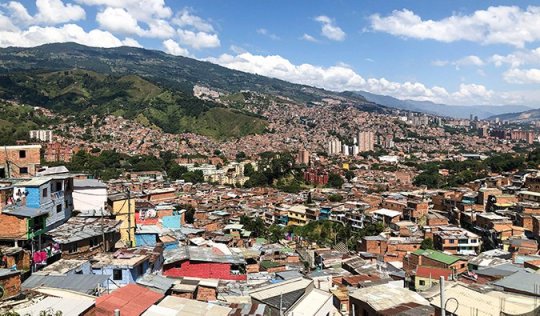
Posted: 4/18/2019 | April 18th, 2019
From the blue waters of Tayrona National Park, the sweeping views of the Cocora Valley, and the ruins of San Agustín, Tierradentro, and the Lost City, to the white colonial buildings of Popayán and the hustle and bustle of its metropolises, Colombia is packed with things to see and do.
I’d wanted to visit Colombia for years. And after spending six weeks there, I must say, it lived up to the hype.
I mean I’ve been fawning over it a lot in my last few posts. And I know I’m the millionth blogger to do so, but it really is as incredible as people say. (Even getting knifed there couldn’t stop me from loving the country.)
I had falsely assumed that six weeks would be enough to get a good sense of Colombia. After all, six weeks is a fair amount of time to spend anywhere.
But I was wrong. Given its size and the sheer number of activities, it was barely enough to scratch the surface.
Yet I did manage to see a lot.
Today I want to share my list of what I think are the best things to see and do in Colombia. These are the activities and places you should try to focus on when you visit:
1. Cartagena
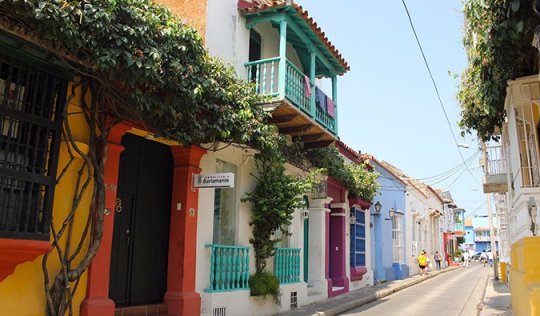
Cartagena is one of the most visited destinations in Colombia (thanks to a lot of direct flights and cruise ship visits). Dating back to 1533, the city is famed for its colonial Old Town: a maze of cobbled alleys, flower-covered balconies, and giant churches on spacious plazas.
But despite the crowds (and there are a lot of crowds), I really enjoyed Cartagena. While there aren’t a lot of tourist activities (you can do most of them in a single day), what makes it a wonderful place to visit is just that: it’s somewhere you can slow down, relax, and gorge on the phenomenal gastronomy.
For more, check out this blog post about Cartegena and all my favorite places to eat there.
2. Tayrona National Park

Located on Colombia’s Caribbean coast, Tayrona has long stretches of golden beaches lined with coconut palms and a dense rainforest with lots of easy day hikes. You’ll also find campsites for overnight stays, hammocks for rent, restaurants, diving, and horse riding.
It’s easy to visit as a day trip from Santa Marta. I highly suggest you start early at the big entrance at El Zaino and exit the park through Calabazo. This underused route takes a whole day, and once you pass the Cabo San Juan campground, you’ll get the last half of the trail to yourself. Try to avoid visiting during January and weekends, when the crowds on the beaches and hiking paths are at their peak.
3. The Lost City (La Ciudad Perdida)

The Lost City was built around 800 CE and contains 169 terraces carved into the mountains, as well as a network of tiled roads and small plazas. It’s one of the most beautiful treks in the country, and the site is older than Machu Picchu! To visit, you need to hire a tour operator (you can’t do it by yourself). It’s about $300-350 USD for the trek from Santa Marta through the jungle up to these beautiful ruins and takes 4–6 days. If you’re pressed for time, you can also do it in three days; the only difference is the pace you go at.
(Tip: You cross a lot of rivers, so be sure to bring an extra pair of shoes or flip flops for when you cross the rivers. You’ll easily ruin a pair of sneakers along the way.)
4. Salento

Surrounded by green mountains and coffee farms, this is one of the oldest towns in the coffee-growing region and the most popular for travelers. The houses are painted a variety of vibrant colors, and the high vantage points throughout town provide some stunning views (sunsets are quite magical). There’s not much to do in the city itself — it’s simply a base for coffee tours or hiking the Cocora Valley (see below) or the trails around town — so it’s easy to spend a few days here watching the world go by with a good book in hand.
5. Cocora Valley

The Cocora Valley is home to Colombia’s national tree, the wax palm, which grows to nearly 200 feet tall. This area has probably the most popular day hike in the country (which was also my favorite activity during my entire trip). You’ll cross jungle rivers, visit a bird sanctuary, and enjoy some stellar views and forest scenery. The route’s about five hours, and you can choose to either take the clockwise or counterclockwise route. The clockwise route, starting at the Wax Palm Valley, is easier, with fewer hills. Counterclockwise is easier at the end, though a little anticlimactic, as you end the hike walking down a boring road.
(Tip: Start early to avoid the brutal midday heat, since there are a lot of exposed areas here.)
6. Bogotá

Bogotá is Colombia’s vibrant capital. While it’s not the country’s most popular destination, it felt the most “Colombian” to me: there was just a certain edge and charm to it, and it seemed the least touristy, with the fewest gringo expats. The historic downtown, La Candelaria, is filled with bright colonial buildings, detailed museums, delicious restaurants, tiny fun bars, historic churches, and centuries-old houses. The north end of town is home to boutique hotels and entertainment areas like Zona Rosa and Zona G. The foodie scene in the city is incredible, with a lot of international options and cutting-edge gastronomic happenings. Throw in some amazing walking tours, day trips, and hikes and you’ve got a recipe for an astounding city.
For more, here’s a list of all my favorite things to do – and places to eat – in Bogota.
7. Cali
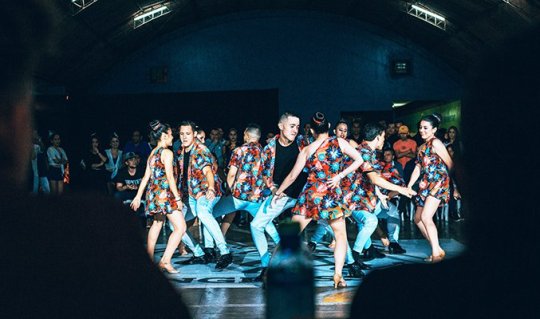
This hot, hot city is the salsa capital of the world, where people come to dance. A lot of the guests at my hostel had been there for weeks to learn (the hostels also offer free dance classes). If you like to dance, you can’t miss this city. Besides dancing, though, there are a number of parks, museums, and churches you can visit, plus free walking and food tours. While I didn’t stay long, I definitely enjoyed the scene.
8. Popayán
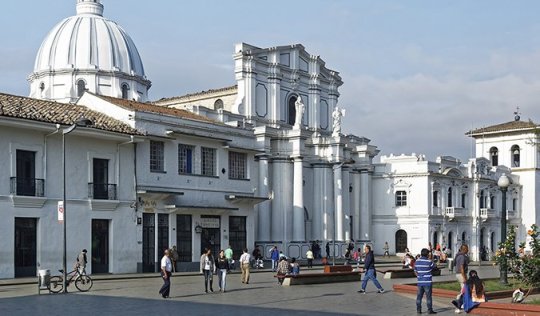
Popayán rivals Cartagena as Colombia’s most impressive colonial town. It’s known as La Ciudad Blanca (“The White City”) because all the buildings are painted white. Popayán is also a college town (there are three universities), and it’s produced 17 presidents too! Though small, I really loved the slow pace of life and the surprisingly robust food scene here (eat at La Cosecha Parrillada, Restaurante Italiano y Pizzeria, La Fresa, and Mora de Castilla).
While you don’t need a lot of time (take the walking tour, climb the hill, see the churches, and you’re done), I do suggest staying longer to enjoy the slow pace of life. So much of Colombia is go-go-go, it’s nice to find a place that’s more “stay and relax a while.”
9. Tatacoa Desert

Millions of years ago it was once a lush tropical forest. Now, Tatacoa Desert is filled with rocky canyons in shades of red and gray. It is also home to one of the most important observatories in South America, where you can gaze at the stars (weather permitting). If you want to be blown away by the universe, you really need to see this place! Other than that, there’s not much here. Bike into the desert, take some walks, stare at the sky. Stay a night or two. It’s not a popular area, but it is a picturesque way to break up the long bus ride from Bogotá to the south or vice versa.
10. San Agustín Archaeological Park
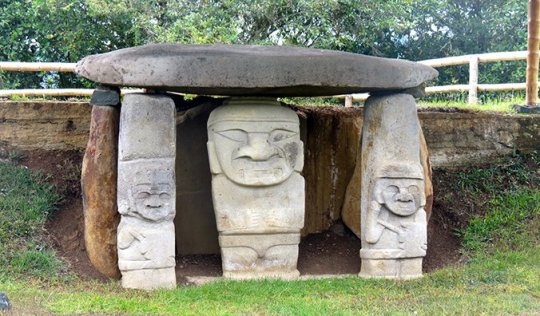
A UNESCO World Heritage Site, San Agustín is a small mountain town that’s home to hundreds of pre-Columbian statues and burial mounds. Its collection of religious monuments and megalithic sculptures is the largest in Latin America, for which you’ll need at least one full day (two to really see it all in depth). If you love history, this is probably the best spot in all of Colombia to experience it.
11. San Gil

San Gil is considered the outdoors capital of the country. Extreme-sports fans love it here. You can go white-water rafting, paragliding, caving, rappelling, trekking, and more from this city! This city is a great place to do outdoor activities and you’re going to find a lot of tour operators in the city. Try to plan at least three days here. It’s worth it.
12. Providencia and San Andrés Islands

These islands are actually closer to Nicaragua than Colombia. They are also considered some of the most unspoiled places in the Caribbean. You’ll find white-sand beaches, stunningly clear blue water, and few crowds (though, thanks to some recent press, Providencia is becoming a lot busier).
Try to make it when tens of thousands of black crabs migrate to the sea. This happens twice a year for about a 1-2-week period between April and July, so it’s not always easy to nail the timing.
13. Medellín

In a country full of hype, this hyped-up city is all that it’s cracked up to be. Set in the Aburrá Valley, Medellín is one of the fastest-growing cities in Colombia. It has enough activities and things to do to fill weeks on end: from microbreweries, museums, walking tours, spacious parks, street art, food tours and markets to incredible nightlife, and on and on and on.
It’s one of the most popular destinations for expats and tourists in the country. While it’s easy to get lost in Gringoland here, try to get out of Poblado or Laureles and see the locals’ side of town.
There’s more to the city than those two areas!
14. Guatapé

This pueblo is one of the most picturesque towns in Colombia and one of the most colorful in the world, as most of the traditional homes have murals painted on the bottom half of their façades that depict animals, people, and shapes. Just hanging out in one of the bright plazas, drinking coffee and people-watching, is one of the most pleasant things to do here.
Most people, though, come to climb the steep (and difficult) staircase to the top of the monolithic Rock of Guatapé (La Piedra) for some of the best views in the country. Guatapé is a long day trip from Medellín (hostels in the city organize them throughout the week) so I recommend trying to spend at least a night here so you aren’t as rushed and can enjoy the area little more.
15. Chingaza National Park

This is one of the biggest nature reserves in Colombia, home to more than 1,000 plant species and 187 bird species. Here you’ll learn about the Páramo ecosystem and how it affects the global water system. (Fun fact: Nearly 80% of Bogotá’s water supply comes from Chingaza.) If you’re going to hike, joining a tour is a good idea. The guides are usually naturalists who can explain the unique environment of the area. One of the best routes is the challenging hike to the summit of Lagunas de Siecha, with a great view over the lakes.
16. Barranquilla
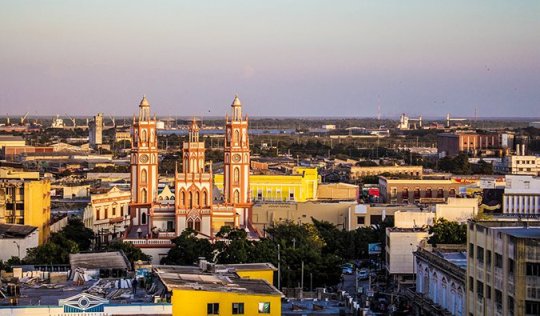
Located between Santa Marta and Cartagena, Barranquilla is the spot to be during Carnival, the second biggest in Latin America. It starts on a Sunday with the Battle of Flowers (a big parade) and the coronation of the King and Queen.
But there’s a lot to do here when it’s not carnival season as well. Make sure you visit El Museo del Caribe, a museum offering an interesting insight into the history of Colombia’s Caribbean coast. There’s also a special exhibit dedicated to Gabriel García Márquez (the famous author who wrote Love in the Time of Cholera).
17. Tierradentro

Tierradentro is one of the most important archaeological sites in South America. It’s up there with San Agustín but gets less press since it’s located in the middle of nowhere and not on a main road. It contains over 100 hypogea (underground tombs) dating from the sixth to the tenth centuries, the only examples of their kind in the Americas. It takes a day or two to hike all the paths around the tombs. You can hire a guide if you want, but the trails are pretty easy to do on your own.
18. Manizales (and Los Nevados)

On the road from Medellín to the south is the city of Manizales. Here, you can take some tours at this northern point of the coffee-growing region, or roam around town, which has some decent restaurants and churches, and a scenic gondola ride. The main reason people visit is to hike Los Nevados, a mountain range with majestic snow-capped peaks. You can do a day or multi-day hikes, but whatever you do, don’t rush up to the top — acclimatize yourself to the altitude in Manizales for a few days first. The town is 2,000 meters (6,500 feet) above sea level, but mountains are about 6,000 meters (19,700 feet)! I wasn’t climatized and could really feel the altitude just walking around town. Don’t push yourself if you want to do the hike.
19. The Caribbean Coast

The beaches on the Caribbean coast might not win any awards (at least in my opinion), but the sleepy towns reminded me a lot of the tiny backpacker beach villages around Southeast Asia: a dirt road, lots of hostels, a relaxed atmosphere, and not much else to do. I could easily see why people end up getting stuck here for weeks at a time. The best beach towns to visit are Costeño Beach and Palomino.
20. Punta Gallinas

Punta Gallinas is the northernmost point in all of South America. Most people come here via a tour from Santa Marta or Cabo de Vela, with the latter (through La Guajira Desert) being the better option if you just want to take your time and relax because it’s closer so there’s a lot less drive time. In fact, the only way to see the area is via a tour. Most are two or three nights depending on where you’re coming from. Any hostel can organize a trip for you.
21. Minca
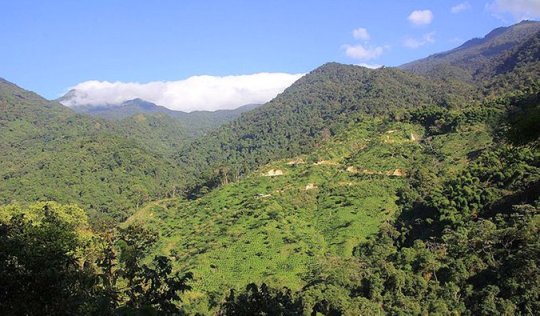
Minca is located in the foothills of the Sierra de Santa Marta Mountains. Once a sleepy backpacker town, it’s now a hot spot for tourists escaping the oppressive heat on the Caribbean coast and hoping to do some quiet hikes. One of the best hikes is to Los Pinos, but it isn’t easy: it takes about three hours from the center of town, and it’s a steady climb into the mountains but, like all things like this, it’s worth it.
There are a lot of waterfalls in the area as well. Two of the best are the Pozo Azul and Marinka. Both have swimming holes at them too.
Be sure to check out the sunset Mundo Nuevo Hostel. It’s an amazing vantage point.
***
Colombia has a million and one things to do. I lost track of all the places I kept wishing I had time to visit. You can spend months there (and a lot of people to do). However, I think this list is a great start. My recommendation is that if you’re short on time, fly (the bus rides are long) or just stick to one area of the country and go in depth around that region.
Trying to “see it all” in Colombia is just a recipe for burnout!
Book Your Trip to Colombia: Logistical Tips and Tricks
Book Your Flight
Find a cheap flight by using Skyscanner or Momondo. They are my two favorite search engines because they search websites and airlines around the globe so you always know no stone is left unturned.
Book Your Accommodation
You can book your hostel with Hostelworld. If you want to stay somewhere other than a hostel, use Booking.com as they consistently return the cheapest rates for guesthouses and cheap hotels. I use them all the time.
Don’t Forget Travel Insurance
Travel insurance will protect you against illness, injury, theft, and cancellations. It’s comprehensive protection in case anything goes wrong. I never go on a trip without it as I’ve had to use it many times in the past. I’ve been using World Nomads for ten years. My favorite companies that offer the best service and value are:
World Nomads (for everyone below 70)
Insure My Trip (for those over 70)
Looking for the best companies to save money with?
Check out my resource page for the best companies to use when you travel! I list all the ones I use to save money when I travel – and I think will help you too!
Want More Information on Colombia?
Be sure to visit our robust destination guide on Colombia for even more planning tips!
Photo credits: 4, 10, 11, 12, 18, 19, 21, 22
The post My 21 Favorite Places to Visit in Colombia appeared first on Nomadic Matt's Travel Site.
from Traveling News https://www.nomadicmatt.com/travel-blogs/best-places-colombia/
1 note
·
View note
Text
Interview from Cuba: Discover Corps’ Guide Orelvis
The passion of Discover Corps’ guide, Orelvis, is clear from the moment you first meet him. His enthusiasm for his country and showing you his country is infectious. As you explore Havana and the surrounding region “Elvis” provides colorful commentary that only deepens your experience. It’s no wonder, that many travelers can’t help but form a strong bond with their insightful guide.
“I remember one time, some [travelers] came back again [to Cuba] through Discover Corps with us, and I remember waiting in the airport. When they saw me and I saw them it was like seeing family. That was a unique emotion and feeling.” – Orelvis
So what better person, to share in his own words, what a trip with Discover Corps like Cuba: Preserving Nature’s Wonders is really like. Take it away Elvis!
The post Interview from Cuba: Discover Corps’ Guide Orelvis appeared first on Volunteer Vacations | Discover Corps.
from Traveling News https://discovercorps.com/blog/interview-from-cuba-discover-corps-guide-orelvis/
0 notes
Text
Our Goa, Hampi & Mumbai South India 2 Week Itinerary
Our Goa, Hampi & Mumbai South India 2 Week Itinerary My amazing Mum has come to visit me in Goa for a couple of...
The post Our Goa, Hampi & Mumbai South India 2 Week Itinerary appeared first on Global Gallivanting Travel Blog.
from Traveling News https://www.global-gallivanting.com/our-goa-hampi-mumbai-south-india-2-week-itinerary/
0 notes
Text
How to Spend Your Time in Tokyo: A Suggested Itinerary for 2019

Posted: 4/25/2019 | April 15th, 2019
Tokyo is one of the most amazing cities in the world. It’s fast-paced, futuristic, and bursting with weird and wonderful activities to keep you busy, including gorgeous shrines, palaces, and temples; hip clubs and bars; and fashionable people and shopping, not to mention cherry blossoms.
Tokyo lives up to all the hype you’ve heard about it.
You never know what you’ll find here. One second you’ll run into a group of women dressed in pig masks and ’80s dresses and the next you’re in a robot café.
Or a centuries-old temple.
It’s also one of the biggest cities in the world, home to over 13 million people — almost 40 million if you count the Greater Tokyo Area. It’s massive!
Not surprisingly, it’ll take some time to see it all. And there are so many nooks and crannies to explore that it’s easy to get lost.
Here is my suggested itinerary on how to visit the best restaurants, sites, and activities in Tokyo:
Table of Contents
Day 1: Fish Market, Ueno Park, and Asakusa
Day 2: Imperial Palace, Below the Girders, and Quirky Cafes
Day 3: Shinjuku, Shibuya, and Robots
Day 4: Take a Day Trip
Day 5: Tokyo Tower, Sumo, and Samurai
Where to Eat
Extra Resources
Tokyo Itinerary: Day 1 – Ueno Park, Museums, and Asakusa

Visit the Tsukiji and Toyosu Fish Market
As of 2018, the main fish market moved to Toyosu. The new market is twice the size of Tsukiji, making it the largest fish market in the world. Just make sure to get a visitor’s pass when you enter.
Eat just-caught sushi for breakfast and marvel at the chaotic atmosphere at the world’s largest tuna market. The auction here powers much of the world’s sushi supply, and it is truly breathtaking. All around you are fish with colors and shapes you didn’t know existed. I have never seen more seafood I couldn’t identify.
The old outer market where you can find food and shops is still in the same location, in Tsukiji. You can still head there to eat and look around but the main market is now in Toyosu.
Tsukiji Fish Market: 5 Chome-2-1 Tsukiji, Chuo, +81 3-3542-1111. Admission is free.
Toyosu Fish Market: 6 Chome-6-2 Toyosu, Koto, +81 3-3520-8205. Open Monday-Saturday from 5am-5pm, though most shops don’t open until 7am. Admission is free.
Relax in Ueno Park
Ueno Park is a lovely spot to spend the day. It’s a perfect spot to photograph the many cherry trees and have a picnic. Don’t miss these sites in the park:
Tokyo National Museum – This museum is in the north end of the park. Established in 1872, this massive building houses one of the world’s largest collections of art and artifacts from Asia, particularly Japan. 13-9 Uenokoen, Taito, +81 3-3822-1111, tnm.jp. Open daily 9:30am-5pm (8pm on most Fridays). Admission is 620 JPY.
Tosho-gu Shrine – This 17th-century Shinto shrine can also be found in the park. It’s beautiful with carved gold doors and ornate carvings. 9-88 Uenokoen, Taito, +81 3-3822-3455, uenotoshogu.com/en. Open daily 9am-5:30pm. Admission is free, though to go further into the shrine, you’ll have to pay 500 JPY.
National Museum of Western Art
Opened in 1959, this is one of the only art galleries in the country to focus on Western art. The collection of almost 5,000 pieces extends from the Renaissance all the way to the 20th century.
7-7 Uenokoen, +81 3-3828-5131 , nmwa.go.jp. Open Tuesday-Sunday 9:30am-5:30pm (8pm on Fridays). Admission is 500 JPY for adults, 250 for college students, and free for seniors and anyone under 18.
Tokyo Metropolitan Teien Art Museum
Built in 1933, this small museum used to be the official residence of the Prince and Princess Asaka. The prince had studied in Paris and wanted to bring the art deco style to Japan, which explains the building’s style and decorations. In 1983, the residence became a museum and is now home to a rotating series of modern art exhibitions.
5-21-9 Shirokanedai, +81 3-3443-0201, teien-art-museum.ne.jp/en. Open daily 10am-6pm. Admission is 200 JPY, with discounts available for students, children, and seniors.
Stroll Along the Meguro River
The Meguro River weaves almost five miles through the city and makes for a magnificent stroll. There’s a path with a bit of green space that follows the water, so plenty of locals walk or exercise there. In the spring, you’ll be able to see a lot of cherry blossoms.
Check out Asakusa
If you want to check out some of Tokyo’s historic religious sites, be sure to spend some time wandering around Asakusa. Two places that I’d suggest you visit are:
Senso-ji – This is Tokyo’s most popular and famous temple. It’s beautifully painted and sits in a scenic spot near a pagoda and the beautiful Kaminari Gate. There’s a huge statue of Kannon, the goddess of mercy, inside the main hall. Look at the “wooden wishes” cards hanging off to the side: you can write your own and join the artistic display. It’s very busy during the day, so maybe check out the grounds in the evening. 2 Chome-3-1 Asakusa, Taito, +81 3-3842-0181, senso-ji.jp. The grounds are open 24/7, though the temple itself is open daily 6am-5pm. Admission is free.
Asakusa Shrine – Not far from Senso-ji is this Shinto shrine. This is much more peaceful than Senso-ji as there are fewer people and you’ll able to see people praying, meditating, or performing traditional rituals. It was built during the Edo period and survived the air raids of World War II. 2 Chome-3-1 Asakusa, Taito, +81 3-3844-1575, asakusajinja.jp. Open daily 9am-4:30pm. Admission is free.
Have Dinner with Ninjas
For a unique dining experience, head to Ninja Akasaka, a ninja-themed restaurant designed like an Edo-era building, with waitstaff clothed in stereotypical all-black garb and trained in all sorts of tricks and illusions. You’ll order off old scrolls while being entertained by the skillful tricks of your server! It’s super fun.
Tokyu Plaza Akasaka, +81 3-5157-3936, ninjaakasaka.com. Open daily 5pm-10:30pm (9:45pm on Sundays)
Drink in Golden Gai
If you are looking for something interesting to do at night, this alley of backstreet bars is a cool spot to start at. There isn’t much going on here during the day, but come sundown, these zigzag hallways and closet-sized beer rooms are filled with interesting people and cheap drinks.
Tokyo Itinerary: Day 2 – Imperial Palace, Below the Girders, and Quirky Cafes
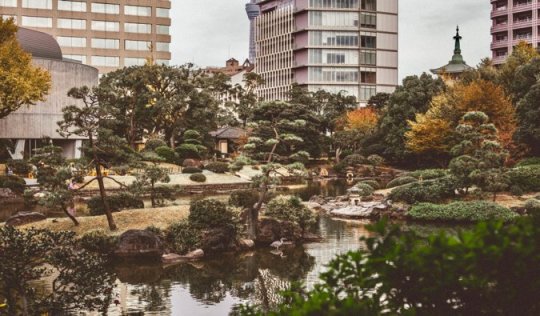
Stop by the Imperial Palace
The Imperial Palace, home to the Emperor of Japan, is a terrific spot to learn about Japan’s history and culture. Formerly Edo Castle, it was built in the 15th century, and some of the walls and moats from that time are still in use to this day. When the Emperor moved from Kyoto to Tokyo in 1869, he took Edo for his new palace and renamed it the Imperial Palace.
Though you can’t go inside (or get super close), the building is amazing. It is surrounded by beautiful grounds and a park, and there’s a moat around the stone walls. You can also see the changing of the guard ceremony, though it’s relatively low-key and unassuming. Admission to the grounds is free.
Visit the National Art Center
Opened in 2007, this museum and gallery doesn’t actually have a permanent collection but rather houses a never-ending series of temporary exhibitions, from impressionism to modern art. Check their website to see what is currently being shown.
7 Chome-22-2 Roppongi, +81 3-5777-8600, nact.jp. Open Wednesday-Monday 10am-5:30pm. Admission varies by exhibit.
Eat Below the Girders
Not far from Ginza is the Yurakucho neighborhood. Below the elevated train tracks at Yurakucho Station is a 700m-long stretch of restaurants and bars. There are wine bars, beer pubs, and casual restaurants filled with businessmen. If you want to get a sense of local city life, this is a good neighborhood to explore after the workday is over.
Superhero Go-Karting
Want to speed around the streets of Tokyo in a go-kart while wearing a costume? Of course, you do! MariCar is a real-life Mario Bros. go-kart company that lets you dress up and race around the city. As long as you have an international driving permit (which you can get if you have a valid driver’s license), you can take part.
4-12-9 Sotokanda, +81 80-8899-8899, maricar.com/en/akihabara.html. Open daily 10am-10pm. The course will take 1-2 hours and costs 9,000 JPY per person. There are multiple locations around the city.
Check out a Sento
A sento is a traditional Japanese public bathhouse. The Japanese are not shy in sentos so you need to be comfortable with nudity! They are typically separated by gender. A budget-friendly sento will cost you just under 1,000 JPY.
Visit a Quirky Café
Tokyo has all sorts of amazing, weird, and wonderful cafés. Monster cafés, owl cafés, cat cafés, vampire cafés, dog cafés, religious-themed cafés, and much more! If you’re looking for something unusual to do, see what weird and quirky cafés are near you (they’re all around the city so you never have to go far to find one!). Here are some suggestions:
Kawaii Monster Café
Vampire Café
Christon Café (Christian-themed café)
Dog Heart (dog café)
Cat Café Calico
Tokyo Itinerary: Day 3 – Shinjuku, Shibuya, and Robots
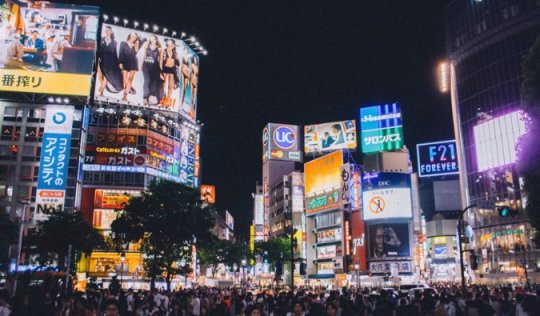
Stroll Around Shimokitazawa
Brimming with vintage shops, this Bohemian neighborhood, often compared to the New York’s East Village showcases the quieter side of Tokyo. Whether you’re looking to shop or just want to take in the scene, it makes for a cool neighborhood to explore.
Stroll through Shinjuku Gyoen National Garden
This park is over 144 acres with some 20,000 trees. Most of the original park was destroyed in World War II during the air raids but was rebuilt and reopened in 1949.
During spring, this beautiful park is one of the best spaces to see cherry blossoms. My favorite part is the Japanese landscape garden, which has several ponds with bridges and islands. It’s a peaceful little oasis within the hustle and bustle of the city.
11 Naitomachi, Shinjuku, +81 3-3350-0151, env.go.jp/garden/shinjukugyoen/index.html. Open Tuesday-Sunday 9am-4pm. Admission is 200 JPY.
Visit Shibuya Crossing
This is quite possibly the busiest and most famous intersection in the world. This area is buzzing at night, with bright lights and frenzied activity, like Times Square on steroids. Make sure to visit the statue between Shibuya Station and the intersection; it’s a tribute to Hachiko, the loyal dog made famous in the film Hachi: A Dog’s Tale.
Eat at the Robot Restaurant
This restaurant is an absolute sensory overload. Lasers, robots, monsters…it has it all! It may be a tourist trap (not cheap), but it is epic, unlike anything you’ve ever seen and worth the price if you want to do something completely out of the ordinary!
1 Chome-7-1 Kabukicho, +81 3-3200-5500, shinjuku-robot.com/pc. There are three performances a day on weekdays starting at 4:45pm, with afternoon matinees on weekends.
Hang with the Harajuku girls
Harajuku is an electric and quirky part of town. You’ll often see teenage “Harajuku girls” walking around town in unique clothing and colorful hairstyles — imagine a 1990s Gwen Stefani video come to life. There’s also a monthly Harajuku Fashion Walk, in which costumed cos-players parade around — for dates, check out the group’s Twitter account (@harajuku_fw).
Experience a Tea Ceremony
No visit to Japan is complete without experiencing a traditional tea ceremony. While these are usually long and expensive experiences, there are definitely some budget-friendly options for anyone looking to experience the ceremony without breaking the bank. Here are a few worth checking out:
Kyoto-kan (500 JPY per person, Yanmar Tokyo Building 1F 2-1-1)
Nadeshiko (2,700-4,400 JPY per person, 2-7-24-2F Asakusa)
The Way of Tea (5,500 JPY per person, Coredo Muromachi 3 3F)
Watch Traditional Japanese Theatre
Kabuki theatre is a traditional form of Japanese performance involving dance and drama. The costumes and makeup are heavily stylized, making for a very visual performance. The Kabukizaka Theatre, located in Ginza, is the best locale to see one of these incredible displays. You can purchase tickets for an entire show or just one act if you’re not ready to commit to a longer performance (they’re in Japanese and last a few hours).
4 Chome-12-15 Ginza, +81 3-3545-6800, kabuki-za.co.jp. Performances are held almost daily. Check the website for the most up-to-date schedule. Expect to pay at least 1,000 JPY for a single-act ticket.
Tokyo Itinerary: Day 4 – Take a Day Trip

Time to take a break from the city and head out on a day trip. Here are some suggestions:
Visit Daibutsu (the Great Buddha)
Make a day trip to Kamakura, where you can see a 13m bronze statue of Buddha. Built in 1252, the statue was initially constructed within a temple, but the temple was washed away — on several occasions — by storms. The statue now sits in the open air.
4 Chome-2-28 Hase, Kamakura, +81 467-22-0703, kotoku-in.jp. Open daily 8am-5:30pm. Admission is 200 JPY.
Get Touristy at Tokyo Disneyland
I’m a sucker for Disney attractions! This is a fun choice for anyone traveling with children, but also for any adults who just love amusement parks. Opened in 1983, it has seven themed areas to explore and is the third most visited theme park in the world!
1-1 Maihama, Urayasu, +81 45-330-5211, tokyodisneyresort.jp/tdl. Open daily 8am-10pm. Admission is 7,400 JPY for adults and 4,800-6,400 JPY for children, depending on age.
Hike Mount Mitake
Located just over an hour from Tokyo is Chichibu-Tama-Kai National Park. The park covers 1,250 square kilometers of rolling hills, mountains, and forests. There are plenty of hiking trails, though you can also take a cable car to the top and then hike to the shrine that sits on the peak, some 930m above sea level.
Gaze at Mt. Fuji from Hakone
Located just over an hour from Tokyo, Hakone is one of the best places to get away from the city, relax for a few days, and take in the view of Mount Fuji. There are numerous guesthouses in the area, many with their own private onsen (hot springs).
Visit the Ghibli Museum
If you’re a fan of famed director Hayao Miyazaki’s work (Spirited Away, Howl’s Moving Castle, Princess Mononoke), then you’ll want to check out this amazing exhibition. It was designed by Miyazaki himself and is an immersive experience that any film buff will appreciate. There is also a new short film every month, only available to visitors. The museum won’t take up a whole day, but it’s not in a very central location so you’ll need to plan accordingly.
1 Chome-1-83 Shimorenjaku, +81 570-055-777, ghibli-museum.jp. Open Wednesday-Monday 10am-6pm. Admission is 1,900 JPY for adults, with discounts available for youth and children. There are limited tickets available each day so book in advance.
Tokyo Itinerary: Day 5 – Tokyo Tower, Sumo Match, and Samurai

Visit the Tokyo Tower
Built in 1957 and resembling the Eiffel Tower, the Tokyo Tower is taller (at 333m) than its European version and made entirely of steel. You can pay to go all the way to the top floor to take in the view, but frankly, the main observation deck offers one that’s just as good.
4 Chome-2-8 Shibakoen, Minato, +81 3-3433-5111, tokyotower.co.jp. Open daily 9am-11pm. Admission is 900 JPY for the main deck or 1,600 JPY for the top.
Visit the Samurai Museum
No trip to Japan would be complete without learning about samurai. While they were known for their martial skill, there was much more to the culture than just mastering the katana (a traditional sword). The museum has some incredible displays of traditional weapons and armor, some of which you can even try on.
Kabukicho 2-25-6, +81 3-6457-6411, samuraimuseum.jp/en. Open daily 10:30am-9pm. Admission is 1,900 JPY per person. You can explore the museum on your own or in a group tour, which are conducted every 30 minutes.
Walk across the Rainbow Bridge
This is the city’s most popular bridge and offers some lovely views of both sides of Tokyo Bay. Built in 1993, the bright lights up at night with rainbow colors — hence the name. It makes for a pleasant walk during the day or at night.
Watch a Sumo Match
Kokugikan, Japan’s most famous sumo wrestling arena, hosts tournaments three times each year. The sumo wrestling that we see today dates back to the 17th century, though its origins date back even further, and it’s still one of the most popular traditions in the country. If you’re in town at the right time, this is a must-do! Tickets sell out quickly so act quick. A visit to one of the sumo stables nearby can be interesting but must be arranged well in advance.
1 Chome-3-2-8 Yokoami, Sumida, +81 3-3623-5111, sumo.or.jp/kokugikan. Ticket prices vary, but expect to pay around 2,200 JPY.
Drinks at the Park Hyatt
New York Bar is the iconic bar from Sofia Coppola’s 2003 film Lost in Translation. Located on the 52nd floor, it actually lives up to the hype of the film. The atmosphere is classy, the drinks are great, and the view is absolutely stunning. There is live jazz every night, and while there is a cover charge (around 2,500 JPY), it’s definitely worth it!
3-7-1-2 Nishishinjuku, +81 3-5322-1234, hyatt.com. Open Sunday-Wednesday 5pm-12am and Thursday-Saturday 5pm-1am.
Where to Eat

Tokyo is so huge and has so many dining options, that it would be impossible to pick just two or three favorites. Here are just a few of my favorite restaurants in Tokyo:
Bifteck Kawamura Ginza – The steak here basically melted in my mouth and exploded with flavor. I found it a bit too high-end and overpriced for me though. 6 Chome-5-1 Ginza, Ginza MST Bldg. 8F, Chuo, 104-0061, +81 3-6252-5011, bifteck.co.jp.
Ichiran Shibuya – This ramen spot served one of the best meals I had my entire trip. The thick, flavorful broth is to die for. I also like how you eat in your own little private booth. Funky. Expect a wait during peak lunch and dinner times. 1 Chome-22-7 Jinnan, Shibuya, 150-0041, +81 3-3463-3667, en.ichiran.com/index.php.
Isakaya Juban – A little hole-in-the-wall izakaya restaurant (think Japanese tapas) with locals getting drunk on sake and eating tasty small plates. I was big fan of its salmon and grilled squid. 2 Chome-1-2 Azabujuban, Minato, 106-0045, +81 3-3451-6873, izakayajuban.com.
Kakimaru – An amazing seafood and tapas place. Be sure to get the oysters. Note: While Google Maps will list the restaurant as Kakimaru, when you go there, the restaurant will be called Uohama. 6 Chome-1-6 Roppongi, Minato, 106-0032, +81-3-5413-3689.
Standing Sushi Bar – This standing sushi location is one of many in town. It’s great for a quick bite: you stand, eat sushi, and get out. It has a robust menu and it’s cheap! 1 Chome-12-12 Nishishinjuku, Kasai Bldg. 1F, Shinjuku, 160-0023, +81 3-3349-1739, uogashi-nihonichi.com.
Tenmatsu Tempura – The tempura here is well known for its lightness. It’s a small establishment with set tempura menus. 1 Chome-8-2 Nihonbashimuromachi, Chuo, 103-0022, +81 3-3241-5840, tenmatsu.com/english.html.
For more places to eat, check out this post on the best places to eat in Tokyo.
Extra Resources

To see what other fun and interesting activities are going on in the city during your visit, here are a few magazines and websites you’ll want to check out:
Time Out Tokyo
Tokyo Weekender
Tokyo Journal
Metropolis Japan
***
Tokyo is a massive city. You could spend a lifetime here and still not discover everything there is to see. But if you follow the itinerary and suggestions above, you’ll be able to have a fun and insightful visit and leave this sprawling capital with a nuanced perspective of what life in Tokyo is like. Best of all, you’ll be able to do it without breaking the bank!
Book Your Trip to Japan: Logistical Tips and Tricks
Book Your Flight
Find a cheap flight by using Skyscanner or Momondo. They are my two favorite search engines because they search websites and airlines around the globe so you always know no stone is left unturned.
Book Your Accommodation
You can book your hostel with Hostelworld as they have the most comprehensive inventory so they are best for booking a hostel. If you want to stay in a hotel or guesthouse in Japan, use Booking.com as they consistently return the cheapest rates for guesthouses and cheap hotels. They’re the best booking site out there. My favorite places to stay in Japan are:
Khaosan Tokyo Kabuki (Tokyo) – This is one of the best hostels in the country. The staff go above and beyond, each room has its own bathroom, and it’s in a great location to help you explore the city.
Sheena and Ippei – This hostel is super homey, and the owners are both helpful and knowledgable. The lounge is open to everyone, and you can enjoy appetizers and sake on the weekends.
Hostel Chapter Two Tokyo – This is a small, family-run hostel in Asakusa. There’s a great view of the river and the dorms seem new and immaculately clean.
Don’t Forget Travel Insurance
Travel insurance will protect you against illness, injury, theft, and cancellations. It’s comprehensive protection in case anything goes wrong. I never go on a trip without it as I’ve had to use it many times in the past. I’ve been using World Nomads for ten years. My favorite companies that offer the best service and value are:
World Nomads (for everyone below 70)
Insure My Trip (for those over 70)
Looking for the best companies to save money with?
Check out my resource page for the best companies to use when you travel! I list all the ones I use to save money when I travel – and I think will help you too!
Looking for more travel tips for Japan
Check out my in-depth Japan travel guide for more ways to save money, costs, tips on what to see and do, suggested itineraries, reading, packing lists, and much, much more!
The post How to Spend Your Time in Tokyo: A Suggested Itinerary for 2019 appeared first on Nomadic Matt's Travel Site.
from Traveling News https://www.nomadicmatt.com/travel-blogs/tokyo-itinerary/
0 notes
Text
Ask the Alumni: Cuba through the Words of a Discover Corps’ Traveler
This Traveler Plans to Return
For Discover Corps traveler, Barbara, her Cuba travel experience was so powerful she is already planning a return trip one year from now. During her adventure, she explored the country, felt the warmth of the Cuban people, and witnessed a moving reunion, years in the making. Barbara provides all the details below of her Cuba: Celebration of Arts & Culture vacation:
Why did you choose Discover Corps versus another travel company?
Service and depth of relationship have been a source of meaning, enrichment and satisfaction for me most of my life. Discover Corps (DC) is true to it’s motto “Vacations With Purpose”. When I first received the catalog, recognized that this was a special kind of travel that incorporates some of my core beliefs. Both of my DC trips, one to Peru and this to Cuba, have been so rewarding in many ways. I believe that travel to another country where one sees and meets the local experience, is one of the most life expanding times. Thank you Discover Corps!
What is one thing you wish you’d known before traveling to Cuba?
I’ve been intrigued by Cuba for some time. I believe that I would have done more reading in regard to the revolution and the power structure that has been in place but is changing due to more progressive leadership. I am continuing my reading of these things and find that I have a deeper understanding even after the trip.
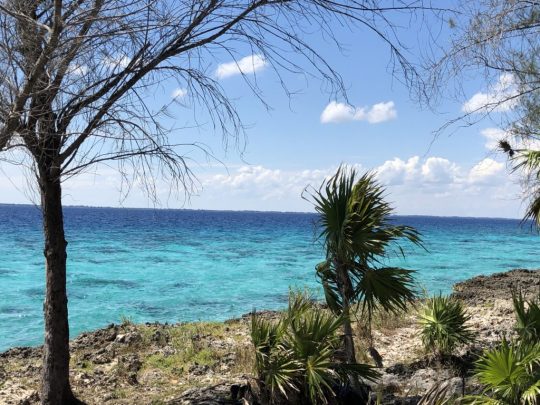
The natural beauty of Cuba
Tell us about the most memorable experience from your trip.
This is hard to just choose one, so I won’t! The place we visited that was so memorable, was Muraleando. The gentleman who had the vision and the means to ‘make it happen’, turned an unused tank that had turned into a junk pile, into a community center where art in all its forms takes place. Classes are given in pottery, painting, dancing, music and other art forms. In addition to being such an intense focus on art, it is a service to the community in providing a beautiful venue for life events such as weddings, at no cost to the participants. I loved every minute in Muraleando!
I must share another experience that made this trip exceptional. One of our group had lived in Cuba until the age of seven. She was part of the Pedro Pan Movement. During the revolution, there were fears for the children. Many fled to other parts of the world with the help of family members who had gone before. Our lovely Carina joined her aunt and uncle, then her parents came three years later. Carina had never been back to Cuba all of these years. One afternoon we went to the address where she knew she had lived the first seven years of her life. She was able to enter and to talk to the current residents. It was a very moving time for her and a very tender time for the rest of us to witness this moment.
Bigger picture, I loved the beautiful and strong expressions of art both on the streets and in galleries and museums. I loved the passion that Cubans have for their history and their future. I loved seeing the light of appreciation when we spoke with local people. They really are a genuinely warm and welcoming people.
“Since returning, I’ve had so many strong responses to the Cuban experience. It seems that it is such an intriguing country to many for numerous reasons. I would like to return in a year to again experience all that it has to offer…I’ll also, probably, take a Salsa Dance class!”
What did you think of your guide? What about your accommodations ?
Tury was beyond exceptional! Always there with so much history and information about a wide range of topics. He was very vigilant about the safety of all of our group. He was delighted to give us, “surprises that I know you’ll love”! And we did! Almost every day there was a wonderful surprise ahead – a stop with a ride on a railway cart, a stop at a yummy fruit stand and the wonderful dance performance that was done just for us. There’s more, but you just need to GO to learn more.
I was pleasantly surprised at how lovely our casa was in Havana. Our host was welcoming and lovely, the rooms were nicely furnished and spotlessly clean. In Trinidad our group was in three different casas, all in the same block. These casas had been renovated in such a lovely manner. Again, the hosts were so gracious and welcoming. On the evening we were on our own for dinner, we found a nice little place right across the street. We were delighted with the service and food. Our waiter was also delighted to have us all fill his little place.

Vibrant Cuban art
Are there any clothes / shoes / toiletries / camera equipment items you’d say are must-brings on this trip?
The Travel Portal on the DC website covered this nicely. I did well with short sleeves and a pashmina as a wrap for evening. We did have lovely rain twice and the umbrella came in handy.
What would you say to someone thinking about traveling to Cuba with Discover Corps?
JUST GO!!! Everyone I’ve shared with has said that they would love to go to Cuba. I can reassure them that travel with DC has been so well supported and implemented.
Anything else you would like to add?
Since returning I’ve had so many strong responses to the Cuban experience. It seems that it is such an intriguing country to many for numerous reasons. I would like to return in a year to again experience all that it has to offer. I often find that reading about a place I’ve been after I was there is more meaningful. I will use this year to read more to have a deeper understanding of the history of Cuba. I’ll also, probably, take a Salsa Dance class!
Five Cuba Travel Options
Discover which Cuba trip is best for you and your family from these 5 options:
Cuba: Building Bridges
Cuba: Celebration of Arts & Culture
Cuba: Family Island Exploration
Cuba: Havana Weekend Getaway
Cuba: Preserving Nature’s Wonders
The post Ask the Alumni: Cuba through the Words of a Discover Corps’ Traveler appeared first on Volunteer Vacations | Discover Corps.
from Traveling News https://discovercorps.com/blog/ask-alumni-cuba-words-discover-corps-traveler/
0 notes
Text
What Kind of Backpacker Are You?
Updated: 4/8/2019 | Originally Posted: 07/29/2009
Note: So much has changed since I originally wrote this post 10 years ago (also, isn’t it crazy that I’ve been blogging for so long?) that I thought that this funny little article needed an update. The Flashpacker is long gone. The Digital Nomad has risen. Others have remained the same.
I redid this entire post on the curious species that is the backpacker after having embedded myself in their culture and learned their curious ways.
***
You always hear about the distinction between tourists and backpackers, but even among backpackers, we love to group each other into categories by who is the “better” traveler. Check into any hostel, and you will find a variety of travelers wearing their distinctive tribal gear and people going “Yeah, that guy over there? Definitely the partier.”
So who are the backpackers? What kind of types have I identified in the hostel jungle? After years of research, many!
Here are some of the more common species of backpackers that can be found in a hostel’s jungle:
The Spiritual Traveler
Usually white, Western, and sometimes young (though there are plenty still trapped in 1969), travelers spiritus have come to find themselves. Exploring local religions and customs, they spend their time reading books on Buddhism, Kabbalah, or yoga and talking about how connected life is. They’ve done ayahuasca in South America. They’ve done yoga in Bali and just “looooooove” Tulum.
Jaded by the materialism of their homeland, they have come to reconnect with the world, find inner peace, and learn some tantra among the tourist centers of India, the hill tribes of Asia, or the shamans of the world. Travelers spiritus forgo material possessions, except for a computer, which they use to blog about the healthy snacks they are eating and tell people how much freer they are now that they have been to six retreats in Bali and went on a juice cleanse.
These backpackers are usually found in South America, India, and Southeast Asia.
The Hippie
Not wanting to be held down by the man, the hippie can be found wearing fisherman pants, dreadlocks, and lots of necklaces, and has a distinct “I haven’t showered in two days” smell. This species of traveler is often thumbing a well-worn book on social justice.
Hippie travelers use local transportation, eat local food, and talk about cultural imperialism while watching the latest Hollywood movies on their Macbook and begging for money to get to the next place. They usually avoid most tourist destinations because “they’re too commercial, man.”
Mostly found in India or other developing countries (because they can’t afford anywhere else).
The Gap Yearer
Traveler gap-yearius is usually college-aged, English, Kiwi, or Aussie. This backpacking species tends to be traveling for exactly one year right before or after university. They follow the main round-the-world ticket route, spending most of their time in Southeast Asia, New Zealand, and Australia.
Gap-year travelers like to party a lot, see the main attractions, sleep in dorms, and tend to stick to the beaten path. They are out to have a good time, meet other travelers, and come home with a few good stories before they start their career.
They can be found wherever a round-the-world ticket will take them.
The Partier
Sporting sunglasses, shorts, flip-flops, and a Lao beer T-shirt, travelers partyoholic spend most of their time getting drunk in each country. Most of their day is spent nursing the hangover from last night while avoiding loud and well-lit areas. You’ll probably see them still in bed when you check in at 2pm. But they’re the first one at the bar each night. Very loud, these nocturnal creatures bounce from one party destination to the other.
Mostly found in “party destinations” like Amsterdam, Thailand, Barcelona, and Prague.
The Couple
The backpacking couple spends most of their time sightseeing, touring, and doing activities. They avoid most of the backpacker ghettos and parties and tend to gravitate toward other couples or older travelers. The younger version often goes the opposite route and tends to party a lot while breaking up about ten times on the road.
They are found worldwide.
The Better Traveler
While sipping on a drink in a hostel, this traveler will tell you how insincere and hypocritical all other travelers are and how they really are just tourists and not trying to find the “local culture.” He will speak about his experience taking local transportation, and that one time he spent living in a village for one day. He waxes on about the death of local cultures, globalization, and how he’s really out there traveling to be part of the world and not force his culture down other people’s throats.
This species is found being hypocritical in hostels all over the world.
The “Remember When” Backpacker
Traveler living-in-the-pastus has been traveling a long time (and usually to the same destinations). He’ll tell you all about how he remembers when the Full Moon Party used to be good and how Laos is too discovered now.
He’ll talk about how Ios used to be quiet and no one had heard of Queenstown. He’ll describe the time when he was the only person in Costa Rica or sailing the Amazon. When asked why he’s still here if he hates it so much, he’ll quickly change the topic.
This depressing species can be found in the same destinations he says are ruined now.
The Digital Nomad
Traveler flashpackosaurus has evolved into a new species called digital nomadosaurus. These creatures work online to afford their travels, often clustering with others of their species in spots like Bali, Chiang Mai, or Medellín.
Carrying laptops, cameras, video cameras, and iPads, they spend much of their time behind their computer touting their free lifestyle and/or recent startup while often never seeing much of the destination they are at. Their first question is always about the Wi-Fi.
They are found behind their computer, talking into their phone, and wherever there is good internet access and a cheap cost of living.
***
Life in a hostel on the backpacker trail sure is interesting. There is a lot of diversity out there in the hostel jungle!
To further investigate the habits of these fabulously interesting creatures, I shall continue to travel the world and stay in hostels.
Ya know, for science!
Book Your Trip: Logistical Tips and Tricks
Book Your Flight
Find a cheap flight by using Skyscanner or Momondo. They are my two favorite search engines because they search websites and airlines around the globe so you always know no stone is left unturned.
Book Your Accommodation
You can book your hostel with Hostelworld as they have the largest inventory. If you want to stay somewhere other than a hostel, use Booking.com as they consistently return the cheapest rates for guesthouses and cheap hotels. I use them all the time.
Don’t Forget Travel Insurance
Travel insurance will protect you against illness, injury, theft, and cancellations. It’s comprehensive protection in case anything goes wrong. I never go on a trip without it as I’ve had to use it many times in the past. I’ve been using World Nomads for ten years. My favorite companies that offer the best service and value are:
World Nomads (for everyone below 70)
Insure My Trip (for those over 70)
Looking for the best companies to save money with?
Check out my resource page for the best companies to use when you travel! I list all the ones I use to save money when I travel – and that will save you time and money too!
The post What Kind of Backpacker Are You? appeared first on Nomadic Matt's Travel Site.
from Traveling News https://www.nomadicmatt.com/travel-blogs/what-type-of-backpacker-are-you/
0 notes
Text
My Pick of The 5 Best Hotels in Hampi (for all budgets)
5 Best Hotels in Hampi (for all budgets) Hampi is, without a doubt, one of India’s most incredible places and one of my favourite...
The post My Pick of The 5 Best Hotels in Hampi (for all budgets) appeared first on Global Gallivanting Travel Blog.
from Traveling News https://www.global-gallivanting.com/5-best-hotels-in-hampi-budgets-best-places-stay-hampi/
0 notes
Text
The Atlas of Happiness: Discovering the World’s Secret to Happiness with Helen Russell

Posted: 4/4/2019 | April 4th, 2019
A few years ago, I read the book The Year of Living Danishly by Helen Russell. I think it originally came up as a suggested book on Amazon. I can’t fully remember. But, I stuck it in my queue, ordered it, and it sat on my bookshelf until it was time to read it. I couldn’t put it down. It was funny, well written, interesting, and an insightful look into Danish culture. It was one of my favorite books I read that year.
Last year, I somehow convinced Helen to speak at TravelCon and got to meet her in person. Now, she has a new book out called The Atlas of Happiness. It’s about why people in certain places are happier than others. It’s a phenomenal book (you should get it). Today, Helen shares some of what she learned in researching that book!
Here’s a funny thing: if you’ve been online today for more than a fraction of a second, you may have started to get the sense that the world is A Terrible Place. Even the committed traveler with an open mind could be forgiven for thinking that the outlook is pretty bleak.
And if you’ve seen the headlines today or been on social media and you’re feeling low as a result, you’re not alone.
It’s easy to get the idea that the world is becoming more miserable by the minute and that happiness is a luxury in these troubled times.
But over the past six years, I’ve learned that there are people all around the world finding ways to stay happy, every day. And that happiness is something we’re hardwired to seek out – wherever we are.
I started researching happiness in 2013 when I relocated from the UK to Denmark. I’d spent 12 years living and working in London as a journalist, and I had no intention of leaving, until out of the blue one wet Wednesday, my husband came home and told me he’d been offered his dream job…working for Lego in rural Jutland. I was skeptical to start with — I had a good career, a nice flat, great friends, close family — I had a life.
Okay, so my husband and I both worked long hours, we were tired all the time, and never seemed to be able to see each other very much. We regularly had to bribe ourselves to get through the day and we’d both been ill on and off for the past six months.
But that was normal, right?
We thought we were ‘living the dream.’ I was 33 years old and we’d also been trying for a baby for as long as either of us could remember, enduring years of fertility treatment, but we were always so stressed that it never quite happened.
So when my husband was offered a job in Denmark, this ‘other life’ possibility was dangled in front of us — the chance to swap everything we knew for the unknown. Denmark had just been voted the world’s happiest country in the UN’s annual report and I became fascinated by this. How had a tiny country of just 5.5m people managed to pull off the happiest nation on earth title? Was there something in the water? And if we couldn’t get happier in Denmark, where could we get happier?
During our first visit, we noticed that there was something a bit different about the Danes we met. They didn’t look like us, for starters — quite apart from the fact that they were all strapping Vikings towering over my 5’3” frame — they looked more relaxed and healthier. They walked more slowly. They took their time to stop and eat together, or talk, or just…breathe.
And we were impressed.
My Lego Man husband was sold on the idea and begged me to move, promising we’d relocate for my career next time. And I was so worn out by my hectic London life that I found myself agreeing. I quit my job to go freelance and decided I would give it a year, investigating the Danish happiness phenomenon first hand — looking at a different area of living each month to find out what Danes did differently.
From food to family life; work culture to working out; and design to the Danish welfare state — each month I would throw myself into living ‘Danishly’ to see if it made me any happier and if I could change the way I lived as a result. I decided I would interview as many Danes, expats, psychologists, scientists, economists, historians, sociologists, politicians, everyone, in fact, to try to uncover the secrets to living Danishly.
I documented my experiences for two UK newspapers before being asked to write a book: The Year of Living Danishly, Uncovering the Secrets of the World’s Happiest Country.
Since then, I’ve been humbled and moved to hear from readers from across the globe with wide-ranging life perspectives, but the one constant was a need to share the happiness secrets of their own cultures. Some of the themes that sprung out were universal — such as social interactions, exercising out of doors and finding a balance in life — while others were intriguingly unique.

So I set out to research into unique happiness concepts from around the world, interviewing people internationally until The Atlas of Happiness — my new book-baby — was born. It isn’t a compendium of the happiest countries; instead, it’s a look at what’s making people happier in different places. Because if we only look at the countries already coming top of the happiness polls, we miss out on ideas and knowledge from cultures we’re less familiar with.
Nowhere is perfect. Every country has faults. But I wanted to celebrate the best parts of a country’s culture as well as national characteristics at their finest – because that’s what we should all be aiming for.
Here are a few of my favorites:
Did you know, for example, that in Portuguese there’s something called saudade — a feeling of longing, melancholy, and nostalgia for a happiness that once was — or even a happiness you merely hoped for?
And while Brazil may be famous for its carnival spirit, the flipside of this, saudade, is so central to the Brazilian psyche that it’s even been given its own official ‘day’ on the 30th of January every year.
Most of us will have experienced a bittersweet pleasure in moments of melancholy — flicking through old photos, or caring about anyone enough to miss them when they’re gone.
And scientists have found that this temporary sadness — counter-intuitively — makes us happier: providing catharsis; improving our attention to detail; increasing perseverance and promoting generosity. So we should all spend time remembering those we’ve loved and lost — then practice being a little more grateful for the ones still around.
Finland ranked number one in this year’s UN World Happiness report thanks to a great quality of life, free healthcare, and education funded by high taxes.
But there’s also something else the Finns enjoy that’s infinitely more exportable: kalsarikännit — defined as ‘drinking at home in your underwear with no intention of going out’ — a pursuit so popular it even has its own emoji, commissioned by The Finnish Foreign Ministry.
In common with most Scandinavians, Finns aren’t shy about disrobing, and they all have such enviably well-insulated houses that stripping down to their pants is apparently completely okay even when it’s minus 35 degrees outside. What you drink and crucially how much of it you knock back is down to the individual, but it’s a uniquely Finnish form of happiness and mode of relaxation that we can all give a go.

In Greece, they have a concept called meraki that refers to an introspective, precise expression of care, usually applied to a cherished pastime — and it’s keeping Greeks happy despite turbulent times. This is because having a hobby improves our quality of life according to scientists, and challenging ourselves to do something different also creates new neural pathways in our brain. Having a passion that you take pride can be of extra benefit to those who can’t say the same for their primary occupation.
Because meraki can make life worthwhile if your 9-5 is more of a daily grind. Many tasks that need to be taken care of on a day-to-day basis aren’t particularly challenging or inspiring – from filing, to raising purchase orders or even — dare I say it — some of the more gruelling aspects of parenting.
But we can break up the never-ending cycle of mundane work with our own personal challenges — things that we’re passionate about that we can genuinely look forward to doing. Our meraki.
Dolce far niente — or the sweetness of doing nothing — is a much-treasured concept in Italy — often hashtagged on Instagram accompanying pictures of Italians in hammocks. Okay, so Italy hasn’t exactly topped any happiness rankings in recent years, but the cliché of the carefree Italian still exists – and with good reason.
Italians do ‘nothing’ like no other nation and perfecting the art takes style and skill – because there’s more to it than meets the eye. It’s watching the world go by over coffee and a cornetto. It’s laughing at tourists. Or politicians. And crucially it’s about savoring the moment and really enjoying the present. Many of us search for relaxation by traveling to exotic locations, drinking to oblivion, or trying to blot out the noise of modern life.
But Italians let the chaos wash over them. Instead of saving up our ‘fun quota’ for an annual escape, they spread it over the minutes, hours and days throughout the year and ‘enjoy life’ in all its messy reality.
One of the happiest countries in the world, the Norwegians must be doing something right. And quite aside from their enviable Scandi-lifestyles and the safety net of all that oil, Norwegians have a secret ace card up their sleeves: a concept called friluftsliv. This roughly translates as ‘free air life’ and it’s a code of conduct as well as a life goal for most Norwegians – who like to spend time outdoors and get high, as often as possible.
Anyone who’s ever visited the country will know that if you meet a Norwegian out in nature, their objective tends to be the highest mountain nearby – and there’s a saying in Norway that “You must make an effort before you can have pleasure’.
Most Norwegians believe you have to work for things, to earn them with physical endeavors, battling the elements. Only once you’ve climbed a mountain in the rain and cold, can you truly enjoy your dinner. It’s an old fashioned approach to the good life but numerous studies show that using our bodies and getting out into nature as often as possible boosts mental and physical wellbeing.

Which is all very well, on paper. But how to apply these principles and all the things I’d learned in real life? Well, I took it slowly — dolce far niente style. I had to learn not to be the archetypal Londoner, working all hours. Instead, I had to try relaxing once in a while.
Radical, I know.
Next, I got on the hobby train. I found my meraki in pottery, in cooking and trying out new recipes, often inspired by the countries I was researching. Some weeks, we ate well. Others, not so much (my husband still hasn’t forgiven me for ‘Russian month’). I’m not ashamed to say that I’ve done a fair amount of underwear-drinking, too.
The Finnish concept of kalsarikännit and I are now firm friends. And because I was working less and being more mindful of living well and looking after myself, it was relatively easy to adopt the Norwegian ethos of friluftsliv.
So now I try to ask myself: what did I do today? What did I climb? Where did I go? But the biggest mind shift was the realization that to be happy, we have to be comfortable being sad sometimes, too. That we’re at our healthiest and happiest when we can reconcile ourselves to all our emotions, good and bad.
The Portuguese saudade was a game changer for me — helping me to come to terms with the life I thought I’d have and find a way to move on, without resentment or bitterness. Because when you let go of these things, something pretty amazing can happen.
By learning from other cultures about happiness, wellbeing and how to stay healthy (and sane), I found a way to be less stressed than I was in my old life. I developed a better understanding of the challenges and subtleties of coming from another culture. My empathy levels went up. I learned to care, more.
Optimism isn’t frivolous: it’s necessary. You’re travelers. You get this. But we need to spread the word, now, more than ever. Because we only have one world, so it would be really great if we didn’t mess it up.
Hellen Russell is a British journalist, speaker, and the author of the international bestseller The Year of Living Danishly. Her most recent book, The Atlas of Happiness, examines the cultural habits and traditions of happiness around the globe. Formerly the editor of marieclaire.co.uk, she now writes for magazines and newspapers around the world, including Stylist, The Times, Grazia, Metro, and The i Newspaper.
Book Your Trip: Logistical Tips and Tricks
Book Your Flight
Find a cheap flight by using Skyscanner or Momondo. They are my two favorite search engines because they search websites and airlines around the globe so you always know no stone is left unturned.
Book Your Accommodation
You can book your hostel with Hostelworld as they have the largest inventory. If you want to stay somewhere other than a hostel, use Booking.com as they consistently return the cheapest rates for guesthouses and cheap hotels. I use them all the time.
Don’t Forget Travel Insurance
Travel insurance will protect you against illness, injury, theft, and cancellations. It’s comprehensive protection in case anything goes wrong. I never go on a trip without it as I’ve had to use it many times in the past. I’ve been using World Nomads for ten years. My favorite companies that offer the best service and value are:
World Nomads (for everyone below 70)
Insure My Trip (for those over 70)
Looking for the best companies to save money with?
Check out my resource page for the best companies to use when you travel! I list all the ones I use to save money when I travel – and that will save you time and money too!
The post The Atlas of Happiness: Discovering the World’s Secret to Happiness with Helen Russell appeared first on Nomadic Matt's Travel Site.
from Traveling News https://www.nomadicmatt.com/travel-blogs/atlas-of-happiness/
0 notes
Text
So, I Got Stabbed in Colombia
Posted: 4/2/2019 | April 2nd, 2019
Editor’s Note: I wavered on writing about this for a long time since I didn’t want to put people off on Colombia. As you can tell from my posts here, here, here, and here, I really love the country. I mean it’s awesome. (And there will be plenty more blog posts about how great it is.) I didn’t want to play into the negative image surrounding the country. But I blog about all my experiences – good or bad – and this story is a good lesson on travel safety, the importance of always following local advice, and what happens when you get complacent and stop doing so.
“Are you OK?”
“Here. Have a seat.”
“Do you need some water?”
A growing crowd had gathered around me, all offering help in one form or another.
“No, no, no, I think I’ll be OK,” I said waving them off. “I’m just a little stunned.”
My arm and back throbbed while I tried to regain my composure. “I’m going to be really sore in the morning,” I thought.
“Come, come, come. We insist,” said one girl. She led me back onto the sidewalk where a security guard gave me his chair. I sat down.
“What’s your name? Here’s some water. Is there anyone we can call?”
“I’ll be fine. I’ll be fine,” I kept replying.
My arm throbbed. “Getting punched sucks,” I said to myself.
Regaining my composure, I slowly took off the jacket I was wearing. I was too sore for any quick movements anyways. I needed to see how bad the bruises were.
As I did so, gasps arose from the crowd.
My left arm and shoulder were dripping with blood. My shirt was soaked through.
“Shit,” I said as I realized what had happened. “I think I just got stabbed.”
***
There’s a perception that Colombia is unsafe, that despite the heyday of the drug wars being over, danger lurks around most corners and you have to be really careful here.
It’s not a completely unwarranted perception. Petty crime is very common. The 52-year civil war killed 220,000 people — although thankfully this number has drastically dropped since the 2016 peace agreement.
While you are unlikely to be blown up, randomly shot, kidnapped, or ransomed by guerrillas, you are very likely to get pickpocketed or mugged. There were over 200,000 armed robberies in Colombia last year. While violent crimes have been on the decline, petty crime and robbery has been on the upswing.
Before I went to Colombia, I’d heard countless stories of petty theft. While there, I heard even more. A friend of mine had been robbed three times, the last time at gunpoint while on his way to meet me for dinner. Locals and expats alike told me the same thing: the rumors of petty theft are true, but if you keep your wits about you, follow the rules, and don’t flash your valuables, you’ll be OK.
There’s even a local expression about it: “No dar papaya” (Don’t give papaya). Essentially, it means that you shouldn’t have something “sweet” out in the open (a phone, computer, watch, etc.) that would make you a target. Keep your valuables hidden, don’t wander around places you shouldn’t at night, don’t flash money around, avoid coming out of nightlife spots alone at night, etc. Simply put: Don’t put yourself in a position where people can take advantage of you.
I heeded such advice. I didn’t wear headphones in public. I didn’t take my phone out unless I was in a group or a restaurant, or completely sure no one else was around. I took just enough money for the day with me when I left my hostel. I warned friends about wearing flashy jewelry or watches when they visited.
But, the longer you are somewhere, the more you get complacent.
When you see locals on their phones in crowded areas, tourists toting thousand-dollar cameras, and kids wearing Airpods and Apple Watches, you begin to think, “OK, during the day, it’s not so bad.”
The more nothing happens to you, the more indifferent you get.
Suddenly, you step out of a cafe with your phone out without even thinking about it.
In your hands is papaya.
And someone wants to take it.
***
It was near sunset. I was on a busy street in La Calendaria, the main tourist area of Bogotá. The cafe I had been at was closing, so it was time to find somewhere new. I decided to head to a hostel to finish some work and take advantage of happy hour.
I’d been in Bogotá for a few days now, enjoying a city most people write off. There was a charm to it. Even in the tourist hotspot of La Calendaria, it didn’t feel as gringofied as Medellín. It felt the most authentic of all the big Colombian cities I had visited. I was loving it.
I exited the cafe with my phone out, finishing a text message. It had slipped my mind to put it away. It was still light outside, there were crowds around, and lots of security. After nearly six weeks in Colombia, I had grown complacent in situations like this.
“What’s really going to happen? I’ll be fine.”
Three steps out of the door, I felt someone brush up against me. At first, I thought it was someone running past me until I quickly realized that a guy was trying to take my phone out of my hand.
Fight or flight set in — and I fought.
“Get the fuck off me!” I shouted as I wrestled with him, keeping an iron grip on my phone. I tried pushing him away.
“Help, help, help!” I yelled into the air.
I remember distinctly the confused look on his face as if he had expected an easy mark. That the phone would slip out of my hand and he’d be gone before anyone could catch him.
Without a word, he started punching my left arm, and I continued to resist.
“Get off me! Help, help!”
We tussled in the street.
I kicked, I screamed, I blocked his punches.
The commotion caused people to run toward us.
Unable to dislodge the phone from my hand, the mugger turned and ran.
***
After people helped me sit down and the adrenaline wore off, I got lightheaded. My ears rang. I had trouble focusing for a few moments.
Blood was dripping through my soaked shirt.
“Fuck,” I said looking at my arm and shoulder.
I tried to compose myself.
Having grown up surrounded by doctors and nurses, I ran through a quick “how bad is this” checklist in my mind.
I made a fist. I could feel my fingers. I could move my arm. “OK, I probably don’t have nerve or muscle damage.”
I could breathe and was not coughing up blood. “Ok, I probably don’t have a punctured lung.”
I could still walk and feel my toes.
My light-headedness dissipated.
“OK, there’s probably not too much major damage,” I thought.
Words I didn’t understand were spoken in Spanish. A doctor arrived and helped clean and put pressure on my wounds. A young woman in the crowd who spoke English took my phone and voice-texted my only friend in Bogotá to let her know the situation.
As an ambulance would take too long, the police, who numbered about a dozen by now, loaded me onto the back of a truck and took me to a hospital, stopping traffic on the way like I was an honored dignitary.
Using Google Translate to communicate, the police checked me in at the hospital. They took down as much information as they could, showed me a picture of the attacker (yes, that’s him!), and called my friend to update her about where I was.
As I waited to be seen by the doctors, the owner of my hostel showed up. After having taken my address, the cops had phoned up the hostel to let them know what happened and she had rushed down.
The hospital staff saw me quickly. (I suspect being a stabbed gringo got me quicker attention.)
We went into one of the exam rooms. My shirt came off, they cleaned my arm and back, and assessed the damage.
I had five wounds: two on my left arm, two on my shoulder, and one on my back, small cuts that broke the skin, with two looking like they got into the muscle. If the knife had been longer, I would have been in serious trouble: one cut was right on my collar and another especially close to my spine.
When you think of the term “stabbing,” you think of a long blade, a single deep cut into the abdomen or back. You picture someone with a protruding knife being rolled into the hospital on a stretcher.
That was not the case for me. I had been, more colloquially correct, knifed.
Badly knifed.
But just knifed.
There was no blade protruding from my gut or back. There would be no surgery. No deep lacerations.
The wounds wouldn’t require any more than antibiotics, stitches, and time to heal. A lot of time. (How much time? This happened at the end of January and it took two months for the bruising to go down.)
I was stitched up, taken for an X-ray to make sure I didn’t have a punctured lung, and required to sit around for another six hours as they did a follow-up. My friend and hostel owner stayed a bit.
During that time, I booked a flight home. While my wounds weren’t severe and I could have stayed in Bogotá, I didn’t want to risk it. The hospital refused to give me antibiotics and, being a little suspicious of their stitching job, I wanted to get checked out back home while everything was still fresh. When I was leaving the hospital, I even had to ask them to cover my wounds. They were going to leave them exposed.
It’s better to be safe than sorry.
***
Looking back, would I have done anything differently?
It’s easy to say, “Why didn’t you just give him your phone?”
But it’s not as if he led with a weapon. Had he done so, I obviously would have surrendered the phone. This kid (and it turned out he was just a kid of about 17) just tried to grab it from my hand, and anyone’s natural instinct would be to pull back.
If someone stole your purse, took your computer while you were using it, or tried to grab your watch, your initial, primal reaction wouldn’t be, “Oh well!” It would be, “Hey, give me back my stuff!”
And if that stuff were still attached to your hand, you’d pull back, yell for help, and hope the mugger would go away. Especially when it’s still daytime and there are crowds around. You can’t always assume a mugger has a weapon.
Based on the information I had at the time, I don’t think I would have done anything differently. Nature just set in.
Things could have been a lot worse: The knife could have been longer. He could have had a gun. I could have turned the wrong way, and that small blade could have hit a major artery or my neck. The knife was so small that I didn’t even feel it during the attack. A longer blade might have caused me to recoil more and drop my phone. I don’t know. If he had been a better mugger, he would have kept running forward and I wouldn’t have been able to catch up as the forward motion made the phone leave my hand.
The permutations are endless.
This was also just a matter of being unlucky. A wrong time and wrong place situation. This could have happened to me anywhere. You can be in the wrong place and the wrong time in a million places and in a million situations.
Life is risk. You’re not in control of what happens to you the second you walk out a door. You think you are. You think you have a handle on the situation — but then you walk out of a café and get knifed. You get in a car that crashes or a helicopter that goes down, eat food that hospitalizes you, or, despite your best health efforts, drop dead from a heart attack.
Anything can happen to you at any time.
We make plans as if we are in control.
But we’re not in control of anything.
All we can do is control our reaction and responses.
I really like Bogotá. I really like Colombia. The food was delicious and the scenery breathtaking. Throughout my visit there, people were inquisitive, friendly, and happy.
And when this happened, I marveled at all the people who helped me, who stayed with me until the police came, the many police officers who assisted me in numerous ways, the doctors who attended to me, the hostel owner who became my translator, and my friend who drove an hour to be with me.
Everyone apologized. Everyone knew this was what Colombia is known for. They wanted to let me know this was not Colombia. I think they felt worse about the attack than I did.
But this experience reminded me of why you can’t get complacent. I gave papaya. I shouldn’t have had my phone out. When I left the cafe, I should have put it away. It didn’t matter the time of day. That’s the rule in Colombia. Keep your valuables hidden. Especially in Bogota, which does have a higher rate of petty crime than elsewhere in the country. I didn’t follow the advice.
And I got unlucky because of it. I’d been having my phone out too often and, with each non-incident, I grew more and more relaxed. I kept dropping my guard down more.
What happened was unlucky but it didn’t need to happen if I had followed the rules.
This is why people always warned me to be careful.
Because you never know. You’re fine until you aren’t.
That said, you’re still unlikely to have a problem. All those incidences I talked about? All involved people breaking the ironclad “No Dar Papaya” rule and either having something valuable our or walking alone late at night in areas they shouldn’t have. Don’t break the rule! This could have happened to me anywhere in the world where I didn’t follow the safety rules you’re supposed to that help you minimize risk.
But, also know, if you do get into trouble, Colombians will help you out. From my hostel owner to the cops to the people who sat with me when it happened to the random guy in the hospital who gave me chocolate, it turns out, you can always depend on the kindness of strangers. They made a harrowing experience a lot easier to deal with.
I’m not going to let this freak incident change my view of such an amazing country. I’d go back to Colombia the same way I’d get in a car after a car accident. In fact, I was terribly upset to leave. I was having an amazing time. I still love Bogota. I still have plans to go back to Colombia. I have more positive things to write about this.
Learn from my mistake. Not only for when you visit Colombia but when you travel in general.
You can’t get complacent. You can’t stop following the rules.
And still go to Colombia!
I’ll see you there.
***
A couple of other points:
They did catch the kid who tried to mug me. There’s security everywhere in Bogotá. He made it one block before they caught him. My hostel owner tells me he is still in jail. He was only 17 too. I feel bad for him. There’s a lot of poverty in Bogotá. There’s a very stark income divide there. Assuming he’s not some middle-class punk, I can understand the conditions that led him to rob me. I hope his future gets brighter.
While the doctors were nice and the stitching turned out to be great, I wouldn’t go to a public hospital in Colombia again. That was not a fun experience. It wasn’t super clean, they had patients in the hallways, they didn’t give me antibiotics or pain medicine or cover my wounds, and they wanted to send me home without a shirt (thanks to my hostel owner for bringing me an extra!). There were just some basic things I was shocked they overlooked.
This is a strong case for travel insurance! I’ve always said travel insurance is for unknowns because the past is not prologue. In my twelve years of travel, I was never mugged — until I was. Then, needing medical care and a last-minute flight home, I was glad I had insurance. I needed it bad. It could have been a lot worse than a $70 hospital bill and a flight back home, too: if I had required surgery or had to be admitted to the hospital, that bill would have been a lot more. Don’t leave home without travel insurance. You never, ever know when you might need it, and you’ll be glad you had it!
Here are some articles on travel insurance:
Why You Should Get Travel Insurance When You Travel
How to Buy the Best Insurance in 2019
World Nomads Travel Insurance Review
10 Common Travel Insurance Questions Answered
Book Your Trip to Colombia: Logistical Tips and Tricks
Book Your Flight
Find a cheap flight by using Skyscanner or Momondo. They are my two favorite search engines because they search websites and airlines around the globe so you always know no stone is left unturned.
Book Your Accommodation
You can book your hostel with Hostelworld. If you want to stay somewhere other than a hostel, use Booking.com as they consistently return the cheapest rates for guesthouses and cheap hotels. I use them all the time.
Don’t Forget Travel Insurance
Travel insurance will protect you against illness, injury, theft, and cancellations. It’s comprehensive protection in case anything goes wrong. I never go on a trip without it as I’ve had to use it many times in the past. I’ve been using World Nomads for ten years. My favorite companies that offer the best service and value are:
World Nomads (for everyone below 70)
Insure My Trip (for those over 70)
Looking for the best companies to save money with?
Check out my resource page for the best companies to use when you travel! I list all the ones I use to save money when I travel – and I think will help you too!
Looking for more information on visiting Colombia?
Check out my in-depth destination guide to Colombia with more tips on what to see, do, costs, ways to save, and much, much more!
Photo credit: 1
The post So, I Got Stabbed in Colombia appeared first on Nomadic Matt's Travel Site.
from Traveling News https://www.nomadicmatt.com/travel-blogs/getting-stabbed-in-colombia/
0 notes
Text
Discover Corps Diet Friendly Locations Guide [Infographic]
Food can be a wildcard when you travel. Will it be tasty, spicy, chewy…cold? Certainly, part of the beauty of traveling is the unknown delicacies that await, but if you’re gluten-free, it’s nice to avoid the guessing game. Let our Diet Friendly Locations Guide point you in the right dietary direction, with countries that have options for vegan, vegetarian, keto, paleo diets, and more:
Sources:
Images credit (in order) – averiecooks.com, whereismyspoon.co, BBC Good Food, kosher.com, Cleveland Clinic Health Essentials, aicr.org, Nutribody, Times Now.
The post Discover Corps Diet Friendly Locations Guide [Infographic] appeared first on Volunteer Vacations | Discover Corps.
from Traveling News https://discovercorps.com/blog/diet-friendly-locations-infographic/
0 notes
Text
20 Things to See and Do in Bogotá

Posted: 03/25/2019 | March 25th, 2019
The capital of Colombia, Bogotá was the home to the region’s indigenous people, the Muisca, when the Spanish came around plundering gold and resources, and it’s been the country’s main city ever since.
Before I went, everyone told me Bogotá wasn’t anything special: dirty, crowded, hard to get around, and lacking the charm of the other big cities in Colombia.
“Spend a few days there and move on,” they all said.
Well, I spent a few days there — and then a few more.
I LOVED Bogotá.
It felt like the most “Colombian” city I visited. It’s not like the gringofied cities in the rest of the country. Its “gritty” nature was what appealed to me.
Bogotá was a vibrant, lively city I couldn’t get enough of.
The museum scene is incredible, there’s a lot of history, a blossoming art community, an exciting food scene, a wild nightlife, and super welcoming people.
It is also a huge city with a ton of tours, day trips, and other things to do. You could easily spend a week here.
To help you make the most out of your visit, here are my top 20 things to see and do in Bogotá.
20 Things to See and Do in Bogotá
1. Take a Free Walking Tour
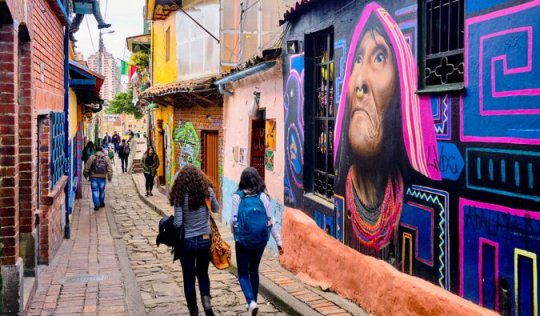
One of my favorite things to do when I get to a new destination is to take a free walking tour. It’s a great way to get the lay of the land, see the main sights, and have a local expert answer any and all of my questions.
BeyondColombia has a great free walking tour that will give you a solid introduction to the city. It also has a free food tour, which is a terrific way to get a taste of some local Colombian dishes (you’ll spend around 18,000 COP/$6 USD on food for the tour). Just be sure to tip your guides!
For a more specialized tour, check out the Bogotá Graffiti Tour. This one operates by donation, using the money raised to reinvest in future community art projects.
2. Stroll in the Botanical Gardens

Opened in 1955, the Botanical Garden of Bogotá is home to almost 20,000 plants. There is a focus on regional plants, usually those that are endemic to the Andes and other high-alpine regions of the continent. It’s a really peaceful place to walk around, and there are some food stalls nearby, so you can grab a quick bite as you explore the gardens and browse the exotic flowers and trees.
Cl. 63 No. 6895, +57 1-437-7060, jbb.gov.co. Open daily 8am-5pm (9am-5pm on weekends). Admission is 3,500 COP for adults and 1,800 COP for children.
3. Climb Monserrate
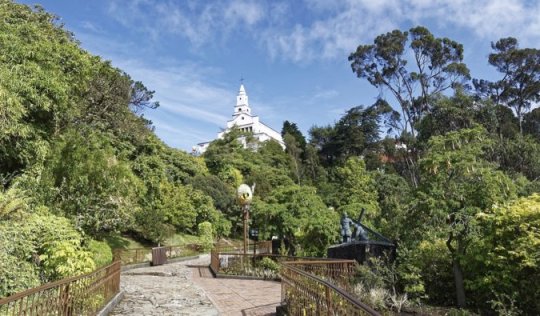
Standing tall at over 3,000 meters, you can see Monserrate from pretty much everywhere in town. It’s a popular spot to take in the view, and since there is a church at the summit, it’s also a popular spot for local weddings. You can walk up yourself in under an hour, or you can take a cable car or funicular to the top. Keep in mind that the walk up isn’t that safe at night or alone — thieves scout out the route. Be careful!
The funicular runs Monday-Saturday 6:30am-11:30am and Sundays 5:30am-4:30pm. The cable car is available Monday-Saturday 12pm-11:30pm and Sundays 10am-4:30pm. Tickets for either vehicle are the same price: round-trip tickets cost 21,000 COP for adults (12,000 COP on Sundays).
4. Visit the Museo del Oro (The Gold Museum)

This is the most interesting museum in the entire country and sees over half a million tourists every year. Opened in 1939, the Gold Museum documents the importance and use of gold in pre-Hispanic civilizations in Colombia and is home to over 55,000 gold items. There’s a lot of information to take in, so be sure to get the audio guide (8,000 COP) or join one of the daily free tours.
Cra. 6 No. 15-88, +57 1-343-2222, banrepcultural.org/bogota/museo-del-oro. Open Tuesday-Saturday 9am-6pm and Sundays 10am-4pm. Admission is 4,000 COP for adults and free for children. Admission is also free for adults on Sundays, but it gets busy quickly so be sure to arrive early!
5. See the Salt Cathedral
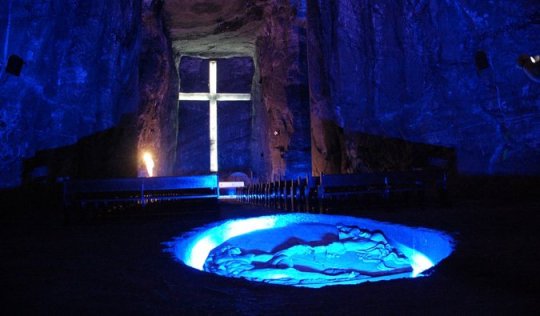
Located about an hour’s drive from the city in Zipaquirá, the Salt Cathedral is a Roman Catholic church that was built in the tunnels of an old salt mine. It’s 200 meters below ground, making this one of the more unique religious sites in the country, if not the world. Every Sunday, up to 3,000 people attend church services here.
Parque de la Sal, +57 315-760-7376, catedraldesal.gov.co. Open daily 9am-5:40pm. Admission is 58,000 COP for foreigners, with discounts available for seniors.
6. Check out the Museo de Botero

Founded in 2000, this museum is home to one of Latin America’s most important art collections. The museum was created after Fernando Botero donated hundreds of his works to the Banco de la República de Colombia with the promise that they would be displayed in a free museum for everyone to see. In addition to his own pieces, included in the donation were works by Monet, Picasso, and other world-famous artists. Take a free tour or get the audio guide (not free).
Cl. 11 No. 4-41, +57 1-343-1316, banrepcultural.org/bogota/museo-botero. Open Monday and Wednesday-Saturday 9am-7pm and Sundays 10am-5pm (closed Tuesdays). Admission is free, and free guided tours are available daily; see the website for updated times. Audio guides are available for 10,000 COP.
7. Explore La Candelaria

I really loved this neighborhood. This is the old part of Bogotá. You can wander the narrow cobblestone streets and take in the eclectic architecture, with art deco, colonial, and baroque styles all calling the neighborhood home. Many of the city’s best attractions (also, many hostels) are here too, such as the Botero Museum, the Gold Museum, and several churches and universities. Watch live music while hanging at Plaza Chorro de Quevedo, try the local chicha (a drink made from corn, often fermented to be alcoholic) on the side streets, and take in some of the amazing restaurants in this district.
8. See the Santuario Nuestra Señora del Carmen

The National Shrine of Our Lady of Carmen is a Gothic church located in La Candelaria. The church has a red-and-white striped pattern — both on the outside and inside — making it look like a giant candy cane. Built from 1926 to 1938, the church stands almost 60 meters tall has some incredible Byzantine and Moorish art.
Cra. 5 No. 8-36, +57 1-342-0972. Open Monday-Friday 7am-7:30am and 10am-4pm, Saturdays 7am-7:30am, and Sundays 7am-12:30pm.
9. Visit Simon Bolívar Metropolitan Park

This is one of the most popular parks in Bogotá. Created in 1979, it spans almost 1,000 acres. You can find people exercising, relaxing, or attending concerts here. The park is named after the famous Simón Bolívar, who led the liberation of the region from its Spanish overlords.
Open daily 6am-6pm. Admission is free unless there is a concert or event in progress.
10. Wander Plaza Bolívar
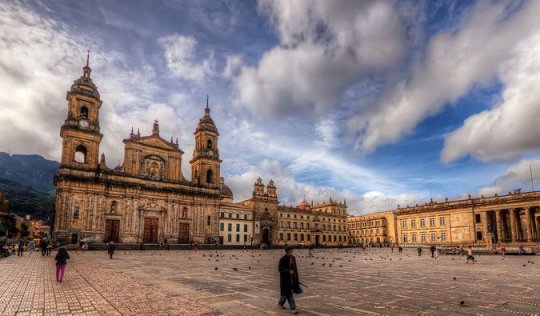
This is the main square of Bogotá, home to Colombia’s Palace of Justice, the Cathedral of Bogotá, the mayor’s office, and the Capitol Building. It’s the historical heart of the city, with buildings from as early as the 16th century. Under the Spanish, the plaza was home to bullfights, circus acts, and public markets. Watch out for the plethora of pigeons!
11. Head to the Laguna de Guatavita (Lake Guatavita)
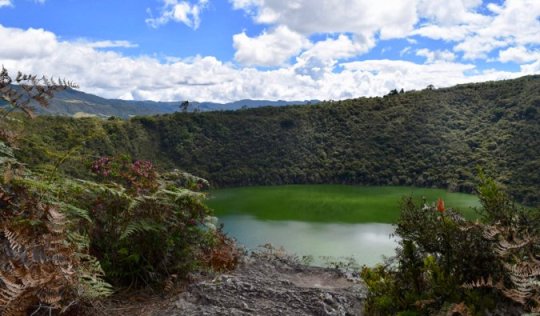
If you want to take a break from the city and get some fresh air, head out on a day trip to Lake Guatavita. Located around 60 kilometers north of Bogotá, this small lake is a sacred site to the region’s indigenous people and is apparently where the rumors of El Dorado originated. There are also hot springs in the nearby town of Sesquilé if you’re in need of some relaxation.
Day trips to the area last around 6 hours and will vary in price. Expect to pay at least 180,000 COP per person.
12. Explore Parque 93

This is the area of town with some of the best restaurants, nightclubs, and bars in the entire city. The park itself is home to an ongoing rotation of temporary art exhibitions. Located in one of the nicer areas of town, you’ll find a lot of good restaurants and cafés lining the park.
13. Attend Gringo Tuesdays
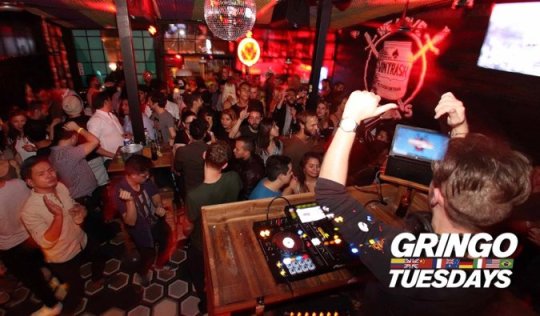
This is a weekly language exchange that evolves into an international party. Every Tuesday, you can meet with other locals and travelers for a few hours of conversation. Once that’s over, the real party begins and goes late into the night. It’s a fun, social night out if you’re looking meet fellow travelers. A lot of hostels organize party buses to the event, so if you’re coming from La Candelaria, this is a good transportation option.
Street 85 No. 11-53, Promenade del Faro, +57 311-492-0249, gringotuesdays.com/en. Every Tuesday, the language exchange occurs 4pm-8pm, followed by the party, which runs 8pm-3am.
14. Discover the National Museum of Colombia
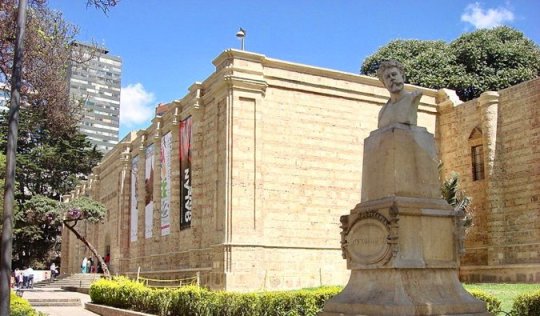
Situated in the heart of Bogotá, this is the oldest and biggest museum in the entire country (and one of the oldest on the continent). Built in 1823, it’s home to over 20,000 pieces of art and historical artifacts, some dating as far back as 10,000 BCE. The building was actually used as a prison initially (it definitely looks imposing) until it transitioned into a museum in 1946. If you’re a history buff or just want to learn more about the country, this museum is a must.
Carrera 7 No 28-66, +57 1-381-6470, museonacional.gov.co. Open Monday-Saturday 10am-6pm and Sundays 10am-5pm. Admission is 4,000 COp for adults, 3,000 COP for students, and 2,000 COP for children aged 5-12.
15. Wander the Usaquén Market
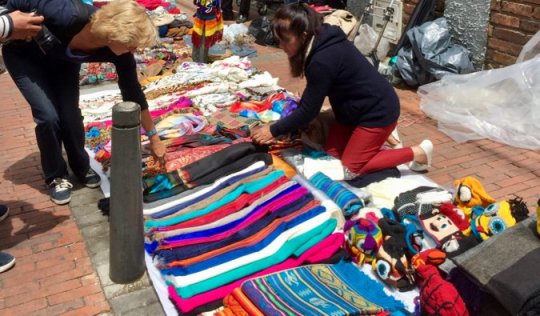
Every Sunday, artisans line the cobblestoned streets to sell all sorts of local crafts and goods. While it’s usually referred to as a flea market, things here are a bit nicer and more upscale than some of the other markets. It’s still quite affordable, though, and makes for a fun way to spend the day.
The market runs 11am-4pm every Sunday in Usaquén.
16. Explore the Museo Santa Clara

This church was built in the 17th century and is actually one of the oldest in the entire country. It was deconsecrated in the 1960s and converted into a museum by the government. There are over 148 baroque paintings that almost entirely cover its walls, making this one of the most beautifully decorated churches you’ll see in Colombia.
Cra. 8 No. 8-91, +57 1-337-6762, museocolonial.gov.co. Open Tuesday-Friday 9am-4:30pm and Saturday-Sunday 10am-3:30pm. Admission is 4,000 COP for adults and 2,000 COP for children.
17. Grab a snack from La Puerta Falsa

This little shop has been serving locals for over 200 years! La Puerta Falsa (The False Door) is a small restaurant with room for fewer than 20 people, yet the tamales and ajiaco soup have been community staples for generations. If you’re looking to try traditional Colombian food, this is the place to go!
Calle 11 No. 6-50, +57 1-286-5091, restaurantelapuertafalsa.inf.travel. Open daily 7am-10pm though its schedule isn’t set in stone.
18. Visit the Iglesia de San Francisco

Built in the 16th century, this Catholic church is the oldest surviving church in Bogotá. The interior is incredibly ornate, with a beautiful altar that dates back to the 17th century. It’s still in use, and you’ll likely see some locals praying during your visit, so make sure to dress appropriately and be respectful.
Av. Jimenez De Quesada No. 7-10, +57 1-341-2357. Open Monday-Friday 6:30am-10:30pm; 6:30am-12:30pm and 4pm-6:30pm on Saturdays; and 7:30am-1:30pm and 4:30-7:30pm on Sundays. Admission is free.
19. Sample the local brews
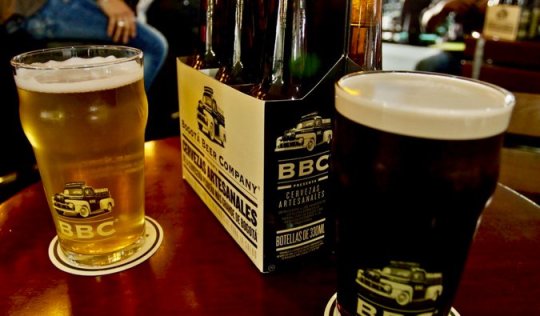
Bogotá (and the country has a whole) has a growing craft beer scene. Bogotá Craft Beer offers a four-hour tour that takes you to some of the best bars and breweries in town. The tour includes a knowledgable guide as well as secure transportation from place to place. I highly recommend it.
Tours are available daily 4pm-9pm and need to be booked in advance via their website. Tickets are around 95,000 COP per person.
20. Take a food tour

Bogotá is a great city for foodies, and the best way to get a sense of the culinary offerings is to take a food tour. Bogotá Food Tour will take you around La Macarena, Bogotá’s bohemian and artistic neighborhood. The tour lasts three hours and will take you to three different restaurants where you can sample a local dish and drink. Tours also include pickup and drop-off at your accommodation.
Tours are available Monday-Saturday and begin around 7pm. Booking in advance is required so you can secure your transportation. Tickets are 188,500 COP per person.
***
It’s true that Bogotá is an “edgy city” with a lot of petty crime. Yet I loved the atmosphere and vibe of the city. It had grit (kind of like Naples, Italy). I loved the art, the museums, the food. The city has so much to offer travelers. You can really fill a lot of time between all the sights, tours, parks, and activities. I would have liked to stay longer in Bogotá if I could.
I’d budget three to five days for your visit. It will definitely be worth it.
Book Your Trip to Colombia: Logistical Tips and Tricks
Book Your Flight
Find a cheap flight by using Skyscanner or Momondo. They are my two favorite search engines because they search websites and airlines around the globe, so you always know no stone is being left unturned.
Book Your Accommodation
You can book your hostel with Hostelworld. If you want to stay somewhere other than a hostel, use Booking.com as they consistently return the cheapest rates for guesthouses and cheap hotels. I use them all the time. My favorite places to stay are:
Masaya Hostel – This is a cool hostel located in La Candaleria. It has lots of common space where you can meet people and some comfy hammocks you can relax in; it also hosts all sorts of activities and excursions, from live music to salsa lessons.
Botánico Hostel – This cool hostel is relvatively new. The beds are comfy, it’s in a good location, and it offers free breakfast too!
Don’t Forget Travel Insurance
Travel insurance will protect you against illness, injury, theft, and cancellations. It’s comprehensive protection in case anything goes wrong. I never go on a trip without it, as I’ve had to use it many times in the past. I’ve been using World Nomads for ten years. My favorite companies that offer the best service and value are:
World Nomads (for everyone below 70)
Insure My Trip (for those over 70)
Looking for the best companies to save money with?
Check out my resource page for the best companies to use when you travel! I list all the ones I use to save money when I travel — and I think they will help you too!
Want More Information on Colombia?
Be sure to visit our robust destination guide on Colombia for even more planning tips!
Photo credits: 13, 14, 15, 16, 17, 18, 21, 20, 21
The post 20 Things to See and Do in Bogotá appeared first on Nomadic Matt's Travel Site.
from Traveling News https://www.nomadicmatt.com/travel-blogs/things-to-see-and-do-in-bogota/
0 notes
Text
Life in Paris: One Month Down

Posted: 3/21/2019 | March 21st, 2019
It’s been exactly one month since I moved to Paris.
During that time, it’s been nonstop wine, cheese, brasseries, influencer meetups, fashionable social events, writer salons, museums, picnics, and late-night jazz concerts.
It’s been a whirlwind of adventure and romance.
Just I imagined it would be.
Actually…
It hasn’t been that way at all.
I just made that up.
Life here has been the exact opposite of that (though that kind of fabulous lifestyle does sound like fun).
I arrived after a much-delayed flight, plopping my jetlagged self into bed and not waking up until the following day. From there, I met my one Parisian friend and her friends for some wine and cheese. That little outing to a park turned into a late-night wine fueled bar crawl that ended at some ’50s-style American sock hop. (Seriously. I couldn’t believe it. Here I am, in a bar in Paris, and people are dressed up and dancing like it’s 1953. It was kind of incredible.)
But, after that wild night, life slowed to a crawl.
I spent my first week here settling in: I got a SIM card, saw a plethora of apartments (and finally picked one), signed up for French classes, and tried to catch up on work. (I thought about joining a gym but, in paperwork-loving France, you need a doctor’s note saying you’re fit enough to join. I’m told most people don’t follow that rule but, for now, I can’t be bothered.)
After that first week, I moved into my new apartment, went to some meetups in hopes of making friends, and flew to Berlin for ITB, the largest travel conference in the world.
Upon returning to Paris, I came down with a terrible cold and spent the last week inside my apartment trying to recover. Just when I had hoped to hit the ground running, life had other ideas.
Now, as I hit my first full month here, I’m finally feeling better (and thanks to spending so long inside, I’m fairly caught up on work).
The timing couldn’t be more perfect. The weather is getting warmer and sunnier again. Over the next few weeks, I start hosting a plethora of visitors, which will finally get me out of my apartment and exploring the city more. (I’ve lined up a lot of activities, which are basically the museums, tours, and shows I’ve yet to see, so my friends are going to get a very off-the-beaten-path look at Paris.)

Life here is very different than what I imagined it to be.
In my head, I imagined hitting the ground running. I imagined perfectly scheduled days balanced with work and play, including regular French classes, meetups, sightseeing, food tours, and nights out. I imagined myself like Owen Wilson’s character from Midnight in Paris where I just wander around town and stumble into this action-packed life.
But, instead, my time here has been similar to when I moved Bangkok where I spent much of my early weeks there alone playing video games, discouraged that life just didn’t “happen” to me.
It took a long time to find my groove in that city.
But living in Bangkok taught me two things:
First, life just doesn’t happen. Sitting at my kitchen table doing work isn’t going to show me life in Paris. Neither is going to the same co-working space.
This first month has gone by the in the blink of an eye, and, with only three more left to go, I know I have to make the most of every single day.
I need to go out and make thing happen. I need to be more proactive in doing things.
But, when I think of some of my motivations for coming here — to escape the fast pace of New York City, to write more, to relax, to sleep, to be healthier — I realize that, by those metrics, my first month has been a success.
I’ve done all those things.
Yeah, it would be nice to live this life I imagine in my head. But what I really want is exactly what I’ve been doing.
Now I feel settled in and ready to take on the city.
So, though, I’m 25% of the way through my time in Paris, I still have plenty of time left to accomplish the other things I want to do.
I didn’t come here in hopes of establishing a new life.
I came here for a fresh start and to try out what it’s like to take a really extended holiday to one of my favorites cities in the world. To no longer be just passing through but rather to peel back some of the layers of the onion that is Paris.
No move to a new place is ever going to be easy.
Because the second thing living Bangkok taught me? If I can make it there, I can make it anywhere.
Bangkok showed me that I could be self-reliant and independent. It showed me that I could adapt to anything.
I’ve done this before.
And I can do it again.
***
I’ve been getting a lot of questions about my time here, so here are some answers to for anyone wondering:
1. How did I find an apartment so quickly?
I got lucky. Someone on Twitter connected me with someone who rented out apartments. And having a decent budget allowed me to find a place quicker. I was going through some agencies and looking at Facebook groups and Le Bon Coin (French Craigslist), but that personal connection made it a lot easier.
Finding an apartment here in Paris is hard even for the French. It’s a long process filled with a lot of paperwork. The way New Yorkers talk about the price of an apartment is the way people here talk about finding an apartment. It’s the first topic of discussion, as a way to bond with strangers.
2. Are you studying French? If so, where?
I was taking French classes at Alliance Française but, disliking the classroom teaching style, dropped out and hired a private tutor. I’m also learning via podcasts and Duolingo.
3. How are you meeting people and making friends as an expat?
There’s a bunch of expat meetup groups I’ve joined, and I started hosting my own meetups. I am also reaching out influencers based in France. But if you know of any cool Parisian locals, let me know!
4. I heard you’re running walking tours. Is that true?
Yep! I started running my own historical walking tours. You can sign up here. I have put up the schedule through the end of May. I do them once a week and they’re free. Come join! If a date is full, join the waitlist. A few people always end up canceling!
Book Your Trip to Paris: Logistical Tips and Tricks
Book Your Flight
Find a cheap flight by using Skyscanner or Momondo. They are my two favorite search engines because they search websites and airlines around the globe so you always know no stone is left unturned.
Book Your Accommodation
You can book your hostel with Hostelworld. If you want to stay somewhere other than a hostel, use Booking.com as they consistently return the cheapest rates for guesthouses and cheap hotels. I use them all the time. Some of my favorite places to stay in Paris are:
St. Christopher’s Canal – Comfy spot on the canal. During the summer months, the terrace is hopping!
3 Ducks Hostel – This hostel has one of the cheapest bars in the city, and it’s just a 10-minute walk to the Eiffel Tower.
Les Piaules – Fantastic chimney lounge, a cool bar, and a rooftop space. It’s a great place to meet people!
Don’t Forget Travel Insurance
Travel insurance will protect you against illness, injury, theft, and cancellations. It’s comprehensive protection in case anything goes wrong. I never go on a trip without it as I’ve had to use it many times in the past. I’ve been using World Nomads for ten years. My favorite companies that offer the best service and value are:
World Nomads (for everyone below 70)
Insure My Trip (for those over 70)
Looking for the best companies to save money with?
Check out my resource page for the best companies to use when you travel! I list all the ones I use to save money when I travel – and I think will help you too!
Looking for more information on visiting Paris?
Check out my in-depth destination guide to Paris with more tips on what to see, do, costs, ways to save, and much, much more!
The post Life in Paris: One Month Down appeared first on Nomadic Matt's Travel Site.
from Traveling News https://www.nomadicmatt.com/travel-blogs/life-in-paris/
1 note
·
View note
Text
My 8 Favorite Hostels in Medellín in 2019
Posted: 3/19/2019 | March 19th, 2019
There are a lot of hostels in Medellín. As “gringo central” for Colombia, you can’t walk five feet without coming across one, with majority located in El Pablado (Gringoland) and Laureles (up-and-coming Gringoland).
In fact, if you look on Hostelworld, you’ll find 93 hostels in this city. That’s a lot of hostels.
I spent close to three weeks in Medellín: first for an extended time over the holidays and then again as I made my way from north to south. Like I do whenever I’m in cities that long, I decided to stay in as many hostels as possible to find out which were the best.
A lot of online lists purport to tell you the best hostels in the city, but I found that my experiences staying in them differed so greatly from the reviews, I began to think, “Ya know, I don’t think people really stayed here!”
So, after spending three weeks there and moving every other day, here is my list of my favorite hostels, based on actual firsthand experience.
The 8 Best Hostels in Medellin
1. Los Patios
This stylish hostel has themed floors inspired by Colombia’s natural surroundings: mountains, jungles, sea, and plains. It’s part of a massive two-building complex that also has a co-working space, a gym, rooftop bars, an organic garden (whose herbs you can use), a Spanish school, and communal kitchens. It was by far my favorite hostel in the entirety of the city. (In fact, I think it is one of the best hostels I’ve ever stayed in!)
Each dorm bed comes with a privacy curtain, and the private rooms are as comfortable as hotels. The bathrooms were amazing and the beds super comfy — I got some of my best nights’ sleep here. It offers free tea and coffee, great happy hours, amazing parties, and activities like salsa classes and street art tours, plus there are free bike rentals. The staff is also super friendly and welcoming. Overall, this hostel just gets it.
Beds from $17 USD, privates from $50 USD.
—-> Click here to book your stay at Los Patios!
2. Hostel Rango Boutique
Hostel Rango is one of the more upscale hostels in the city. The dorm beds are super comfy, though the beds lack privacy curtains. Each bed comes with reading lights, two power sockets, and personal lockers. The bathrooms are nicer than anything I’ve ever seen in a hostel and rival that of a luxury hotel. I mean, that water pressure! That rustic design? So good! I want these bathrooms in my home. Private rooms are also available and come with a few additional touches, like TVs and mini-fridges, but they are as expensive as hotels, so skip them.
I found the open, industrial décor is super fashionable, and the hostel’s restaurant and bar area great for grabbing a meal and a really good professional cocktail (honestly the bar alone is worth visiting). The staff will also help to set you up with activities like food tours and free walking tours.
Beds from $18 USD, privates from $75 USD.
—-> Click here to book your stay at Hostel Rango Boutique!
3. Sugar Cane Hostel
German- and Colombian-owned Sugar Cane is small. There are just a few private and dorm rooms on one level. The rooms are impressively clean, although they lack the character of the larger hostels in town. The roof has a common area with a few hammocks as well as the hostel’s kitchen. Breakfast is free (you serve yourself) and comes with all the essentials, like bread, eggs, muesli, coffee, and tea. Every Sunday the German owner (I forget his name) cooks up his famous barbecue of chicken, steak, sausages, and all the fixings! It’s a pretty standard, simple hostel, but the owner really makes you feel like family, and he helped me a lot during my stay.
Beds from $10 USD, private rooms from $28 USD.
—-> Click here to book your stay at Sugar Cane Hostel!
4. Happy Buddha Boutique Hostel
This is the largest party hostel in Medellín, so if you’re looking to get crazy, this your best bet! The staff works hard to keep people happy (and drunk), including organizing drinking games, salsa classes, and pub crawls. You’ll get free breakfast and coffee in the mornings. The drink are cheap here and there are two on-site restaurants selling sushi and tacos.
Thankfully, the huge bar area is separate from the rooms, so it’s pretty quiet. But the rooms are fairly basic and the beds nothing special — you’ll sleep but won’t be blown away by anything. The real reason to come here is to be in the middle of the party! A lot of pub crawls stop here.
Beds from $10 USD, private rooms from $28 USD.
—-> Click here to book your stay at Happy Buddha Boutique Hostel!
5. The Wandering Paisa
The Wandering Paisa is located in the upscale area of Laureles, which is the up and coming touristy area. All the dorms are covered in South American and Colombian cultural artwork by local students. Each bed comes with a large locker and a privacy divider, which makes it easier to sleep. While the beds are average, I was a big fan of the nice pillows. The kitchen is has the basic essentials. The Paisa Bar is a fun spot to hang out in, and local musicians perform on the sundeck. The hostel also offers free salsa lessons and Spanish classes. If you want to get out of Poblado, this is the place to stay.
Beds from $8 USD, private rooms from $23 USD.
—-> Click here to book your stay at The Wandering Paisa!
6. Black Sheep Hostel
The Black Sheep Hostel, one of Medellín’s most popular, was also the first in town. I really loved this hostel. The rooms, while pretty bare, are spotless, and the bathrooms have great water pressure and are cleaned regularly. There are lots of common spaces here, including a large balcony and terrace area. The beer sold is cheap and I found guests here were always socializing and hanging out (the way they should). The Kiwi staff owner is super nice and staff members are all university students that are great at handing out local advice. The hostel also offers a ton of tour options that you can book directly from and they’ll even exchange money if you need. This is another “classic” hostel that gets everything right! I loved it.
Beds from $11 USD, private rooms from $25 USD.
—-> Click here to book your stay at Black Sheep Hostel!
7. Purple Monkey
This is definitely one of the liveliest party hostels in Medellín. It’s quirky and upbeat, with a massive rooftop bar area. I found the dorms to be small and cramped, and it was a bit weird to go upstairs and outside to the shower area, but the place is kept very clean, there’s free breakfast, and you really only come here to party, so who cares about anything else!
Beds from $11 USD.
—-> Click here to book your stay at Purple Monkey!
8. Casa Kiwi Hostel
Casa Kiwi Hostel is another institution and located in the middle of Poblado. The dorms are small and I found the beds to be a little thin, but each bed has a locker, and overall, the building is clean and tidy. There’s a big kitchen with free coffee and tea, but the hostel’s restaurant serves up tasty and cheap food. It also has a rooftop terrace, a plunge pool, a bar, plenty of hammocks, and a mini-theater. As one of the most popular hostels in the city, it’s really easy to meet people here, as it’s always full!
Beds from $11, private rooms from $31 USD.
—-> Click here to book your stay at Casa Kiwi Hostel!
***
Two places I would not recommend staying are Monet’s and Selina. Monet’s is new and cheap and has friendly owners, but it’s far from the action, the walls are thin, and the accommodations pretty basic. If you were on a tight, tight budget and everywhere else was full, it would be good for a night. I wouldn’t spend more time there than that.
Selina is a super popular hostel with digital nomads and has locations around the world. It’s always so hyped up that I was pretty excited to stay there. However, I was greatly disappointed with it. It was good spot to work from (they have a co-working space), there are resturants on site, and the bar, though overpriced, was nice place to meet expats and travelers, but the beds were hard, the rooms had little privacy, and the bathrooms weren’t well kept. Given the high premium it charges, I just didn’t see the value in staying there. Better to stay elsewhere and go party at Selina instead! You get more bang for your peso elsewhere.
***
So there you have it: the best hostels in Medellín based on my recent firsthand experience. You can’t go wrong with any of them, but by far the best, best, BEST hostel in the city is Los Patios. It’s one of the greatest hostels I’ve ever stayed in!
Did we miss any? If you have any suggestions, leave them in the comments.
Book Your Trip to Medellin: Logistical Tips and Tricks
Book Your Flight
Find a cheap flight by using Skyscanner or Momondo. They are my two favorite search engines because they search websites and airlines around the globe so you always know no stone is left unturned.
Book Your Accommodation
You can book your hostel with Hostelworld. If you want to stay somewhere other than a hostel, use Booking.com as they consistently return the cheapest rates for guesthouses and cheap hotels. I use them all the time.
Don’t Forget Travel Insurance
Travel insurance will protect you against illness, injury, theft, and cancellations. It’s comprehensive protection in case anything goes wrong. I never go on a trip without it as I’ve had to use it many times in the past. I’ve been using World Nomads for ten years. My favorite companies that offer the best service and value are:
World Nomads (for everyone below 70)
Insure My Trip (for those over 70)
Looking for the best companies to save money with?
Check out my resource page for the best companies to use when you travel! I list all the ones I use to save money when I travel – and I think will help you too!
Looking for more information on visiting Colombia?
Check out my in-depth destination guide to Colombia with more tips on what to see, do, costs, ways to save, and much, much more!
Photo credits: 2, 3, 4, 7, 8, 9, 10
The post My 8 Favorite Hostels in Medellín in 2019 appeared first on Nomadic Matt's Travel Site.
from Traveling News https://www.nomadicmatt.com/travel-blogs/best-hostels-medellin/
0 notes
Text
Interview from Thailand: Discover Corps’ Guide Tam
After being a tour guide for so many years, you might think Discover Corps Guide Siwarkorn Hkt, or “Tam”, has probably done and seen it all. There’s something, however, that keeps him smiling and talking about how much he loves his job: the people. Of course, the wildlife and beautiful scenery on the Thailand: Elephants & Islands Expedition are incredible, but it’s the people that really stand out for him. From the conversations and shared experiences between travelers, to the time spent with locals, these relationships built while on your volunteer vacation stay with you for a lifetime.
“On the second day of elephant camp when we return in the morning time, the elephant makes noise to say hi or hello…the elephant remembers you, it smells you, it remembers your face and also your voice!” – Tam
Tam expertly guides travelers to historic sites, panoramic views and up-close encounters with another huge (literally) motivation to travel to Thailand: the elephants! Hear it from Tam himself in the video below as he provides an in-depth rundown of what to expect on this family-friendly adventure:
The post Interview from Thailand: Discover Corps’ Guide Tam appeared first on Volunteer Vacations | Discover Corps.
from Traveling News https://discovercorps.com/blog/thailand-elephants-islands-expedition-discover-corps-guide-interview/
0 notes
Text
This is Not Your Parent’s Colombia

Posted: 3/14/2019 | March 14th, 2019
Colombia’s troubled past – cartels, paramilitaries, poverty, petty crime — casts a long shadow that still reaches to today. The country is still viewed by many as a place where danger lurks around every corner.*
Having grown up hearing stories of Colombian drug lords, kidnappings, murders, and muggings, these ghosts haunted the back of my mind as prepared to visit the country.
Was the country going to be safe? Should I bring my electronics?
The stories and images we grow up with don’t leave us easily. They slide to the recesses of our mind and wait there, ready to jump back to the forefront and whisper fear into our ears.
Even though I knew otherwise, the old image of Colombia — born of decades of media bombardment — still circled around me as I touched down in Medellin.
It quickly evaporated once face with reality.
Colombian history is just that. History.
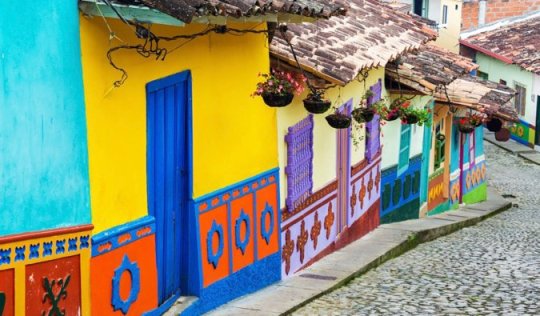
Yes, there are still many problems here in Colombia: the drug trade is still strong, paramilitaries still exist, and petty crime is a major problem. The murder rate, though falling dramatically over the last decade, was still 11,781 in 2017 and petty crime and armed robbery are still a regular occurrence with 2018 seeing over 200,000 armed robberies in the country.
Locals often suggested not going out to certain areas at night and being extra careful with my stuff. There are still issues with the paramilitaries (there was a bombing while I was there by the National Liberation Army, a radical paramilitary group). Income inequality is high. Poverty is rife. About 29% of the population lives below the poverty line.
Colombia is not perfect. It’s still growing, it’s still developing, and it still is trying to cast off the long shadow of its troubled past.
But the big cartel days are over, and most paramilitaries have entered peace agreements with the government. Major crimes are decreasing each year. Kidnapping has decreased by 92% since the cartel years and homicides have dropped by around 50% over the past two decades.
Poverty is decreasing as well. Since 2002, when the government started tracking poverty statistics, the poverty rate in the country has dropped from almost 50% to 29% — and it’s still dropping by around 3% each year. On top of that, their GDP per capita has increased almost five-fold since 1980.
Slowly but surely, things are improving.
Tourism from around the globe is on the rise, as well, with tourism doubling since 2010.
Foreigners are moving there in droves (Colombia gets a new immigrant every 18 minutes). The country is a hub for digital nomads and tech companies like WeWork, Facebook, and Google. It’s making big strides, generally dispelling visitors’ previous preconceptions.
Danger doesn’t lurk around every corner the way it used. Colombia is a country on the move and people are eagerly wanting to shed its past.
This is not our parents’ Colombia.

The country constantly blew away all my expectations. (Even my dad, who was sure I was going to get kidnapped, commented after seeing my photos that it wasn’t anything like he thought it was.)
The people were curious, friendly, warm, and helpful. I had some great conversations with students and Uber drivers (I bonded with one over classical music and another over our mutual love of the book The 5 Love Languages). Colombians I met in Cartagena took me out and treated me like we had been friends forever. I had countless other positive encounters with people who seemed generally happy to show their country to visitors.
The infrastructure rivaled what you see in the advanced countries of Europe. Seriously, the roads, the ski-style gondolas leading into the mountains, the subways, the rapid bus routes, the trams — I only wish the United States had such a comprehensive system.
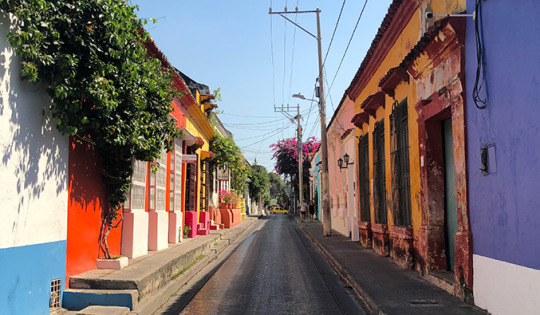
The culinary scene — high-class gastronomy throughout, mixed with incredible hole-in-the-wall restaurants and ceviche and fruit smoothie street vendors — is one of the most eclectic and cutting-edge in the region.
And with lightning-fast Wi-Fi and tons of cafés, I found working there a breeze.
Colombia is packed with things to do and see, from beautiful colonial towns like Popayan and Cartagena to vibrant cities such as Bogotá and Medellín, from dancing in Cali to the Lost City Trek, from the beaches of the north to hikes in the coffee region, from the desert of Tatacoa to the ruins of San Agustín.
I thought that spending six weeks in the country would allow me to dig a little deeper, but even with that amount of time, I still barely scratched the surface.
Colombia is no Shangri-La.
But it’s damn close.
I give it an 11 out of 10.
It may be clichéd to say but I can’t wait to go back. Colombia was one of the best countries I’ve visited in years.
I can’t speak highly enough about it.
Book Your Trip to Colombia: Logistical Tips and Tricks
Book Your Flight
Find a cheap flight by using Skyscanner or Momondo. They are my two favorite search engines because they search websites and airlines around the globe so you always know no stone is left unturned.
Book Your Accommodation
You can book your hostel with Hostelworld. If you want to stay somewhere other than a hostel, use Booking.com as they consistently return the cheapest rates for guesthouses and cheap hotels. I use them all the time.
Don’t Forget Travel Insurance
Travel insurance will protect you against illness, injury, theft, and cancellations. It’s comprehensive protection in case anything goes wrong. I never go on a trip without it as I’ve had to use it many times in the past. I’ve been using World Nomads for ten years. My favorite companies that offer the best service and value are:
World Nomads (for everyone below 70)
Insure My Trip (for those over 70)
Looking for the best companies to save money with?
Check out my resource page for the best companies to use when you travel! I list all the ones I use to save money when I travel – and I think will help you too!
Looking for more information on visiting Colombia?
Check out my in-depth destination guide to Colombia with more tips on what to see, do, costs, ways to save, and much, much more!
*I don’t mean just in the United States. Colombia has become incredibly popular with Dutch travelers thanks to a popular TV show that takes place here but many told me that older Dutch residents still ask “Why are you going to Colombia? It’s dangerous.” Old patterns die hard…no matter where you are in the world.
The post This is Not Your Parent’s Colombia appeared first on Nomadic Matt's Travel Site.
from Traveling News https://www.nomadicmatt.com/travel-blogs/amazing-colombia/
0 notes